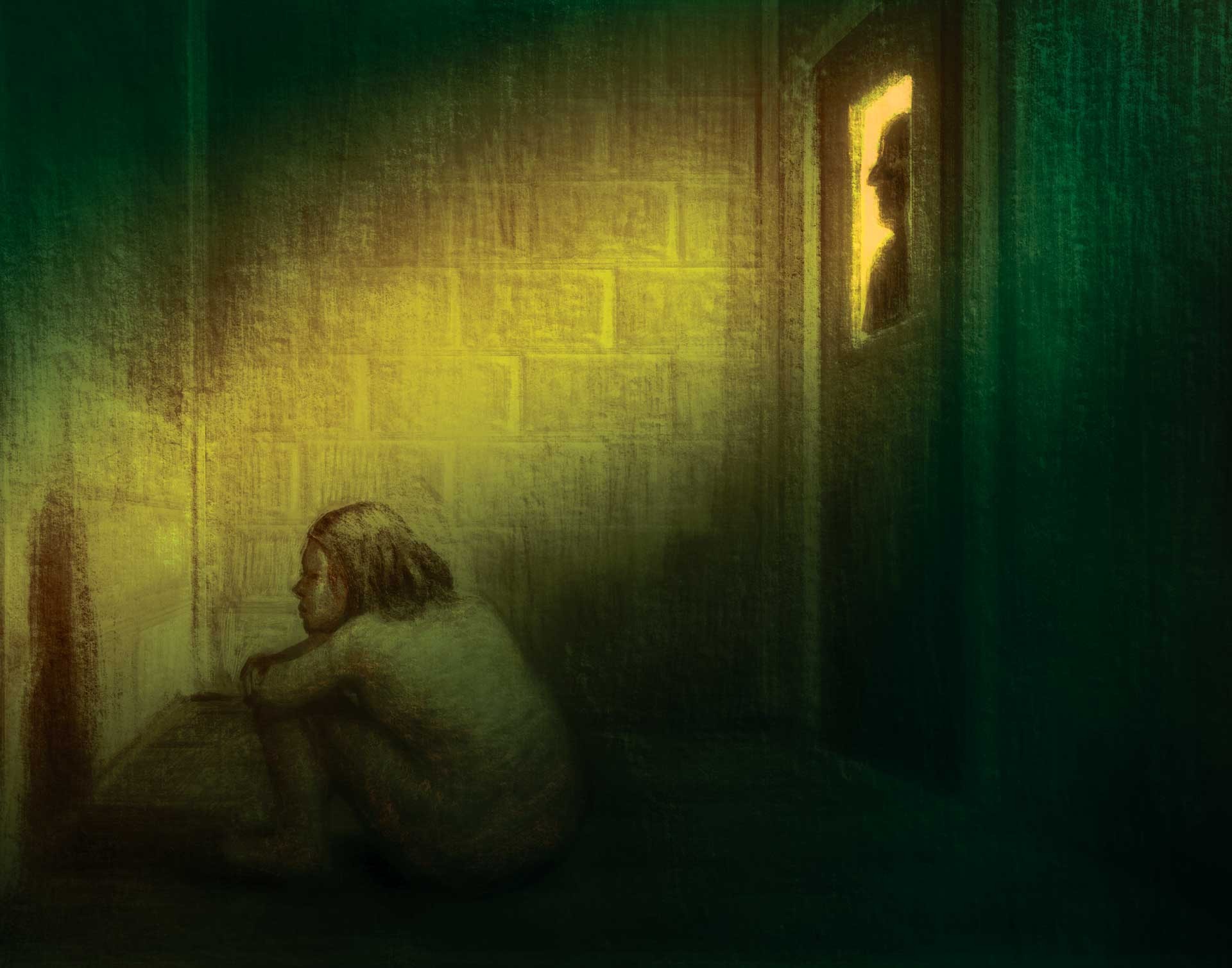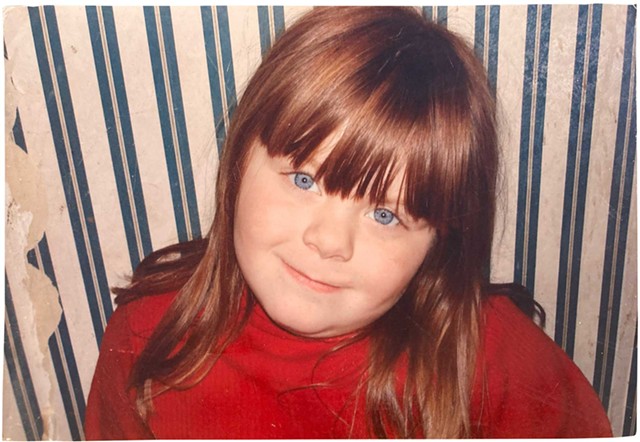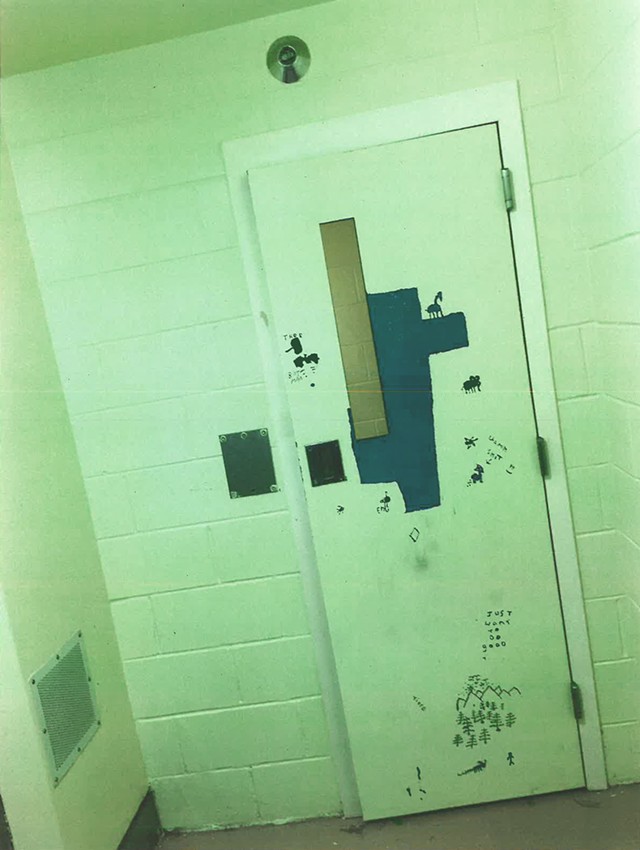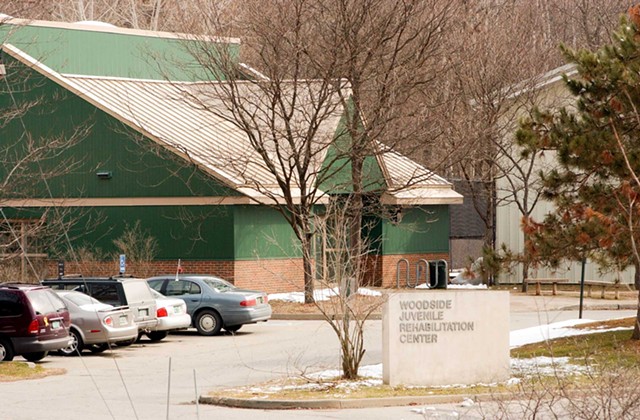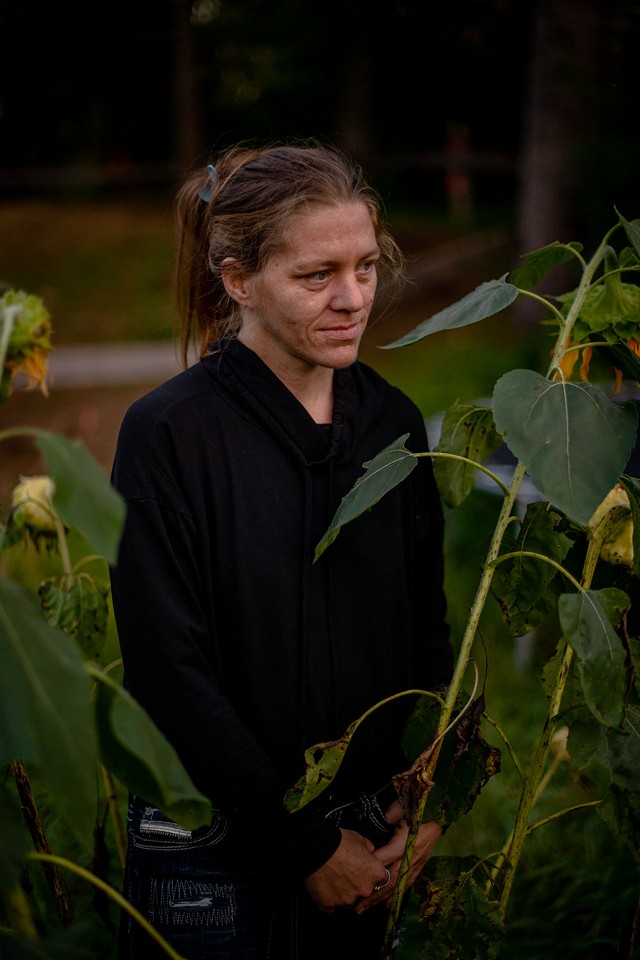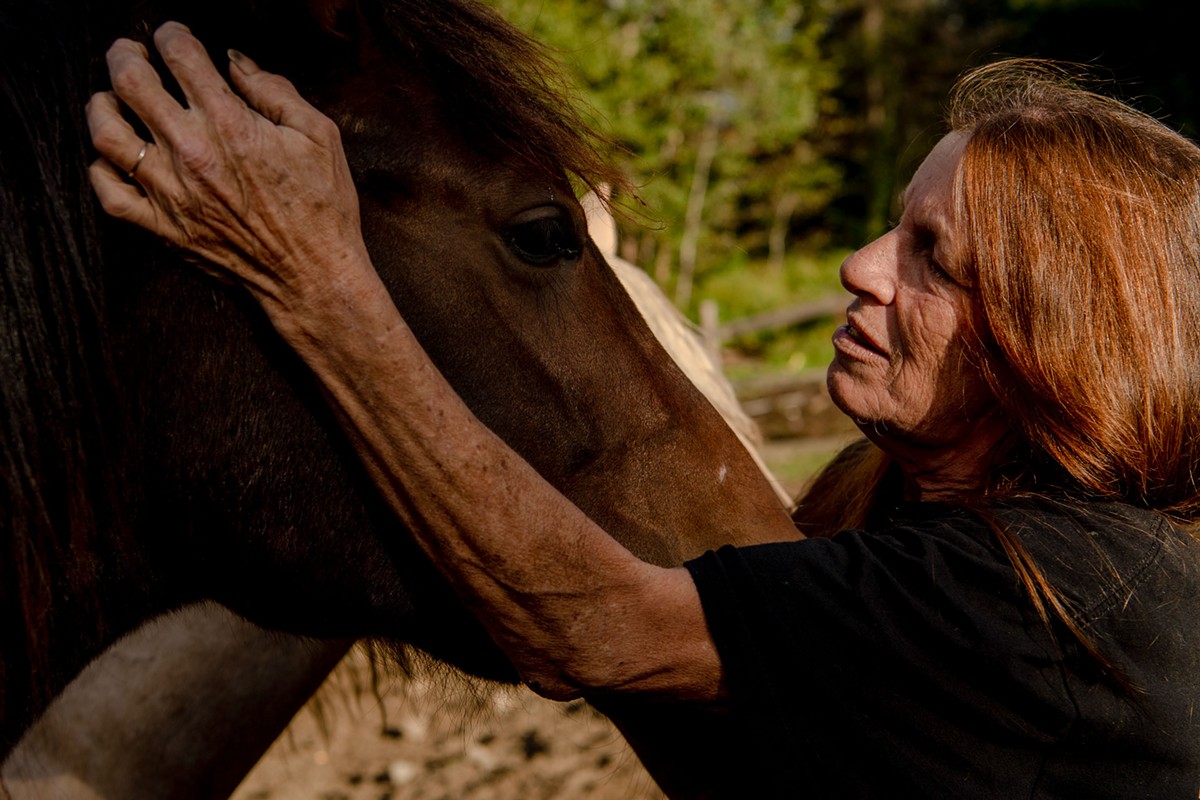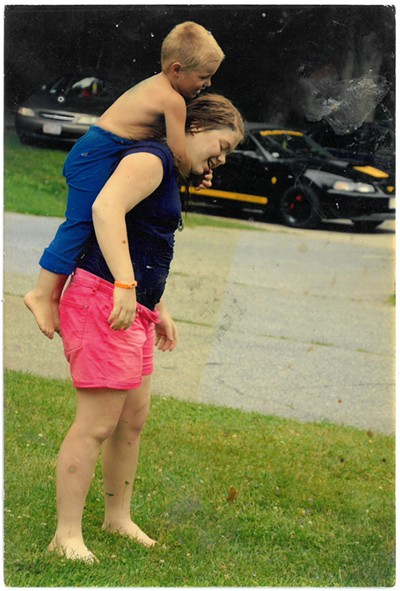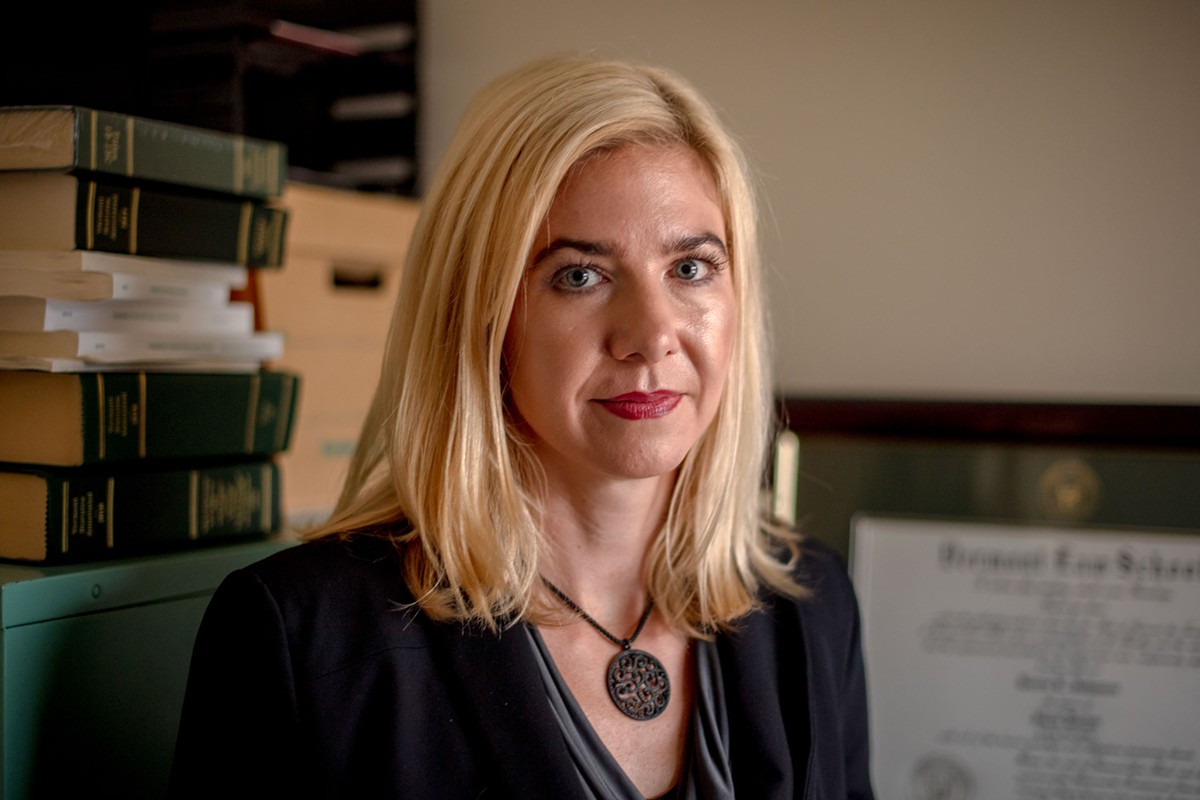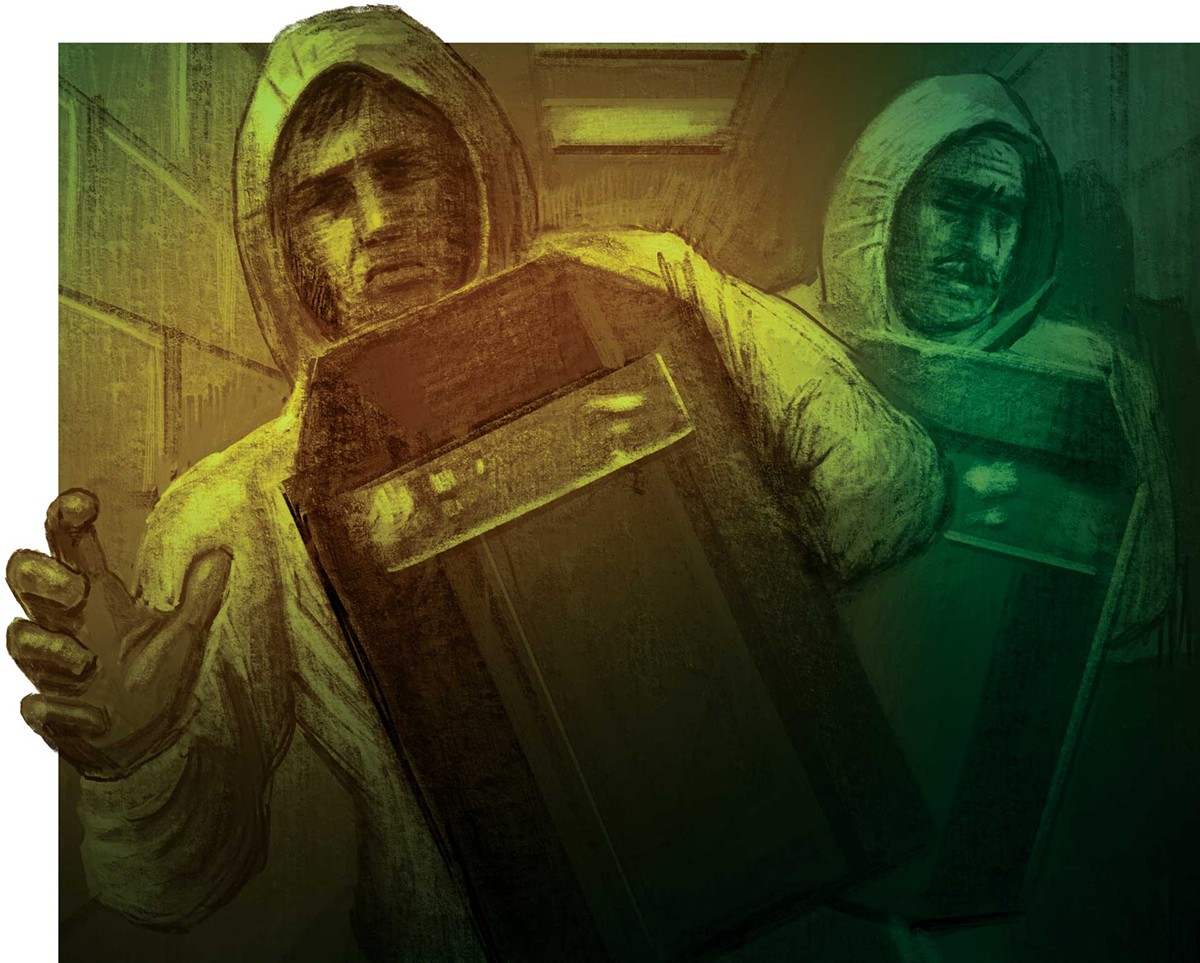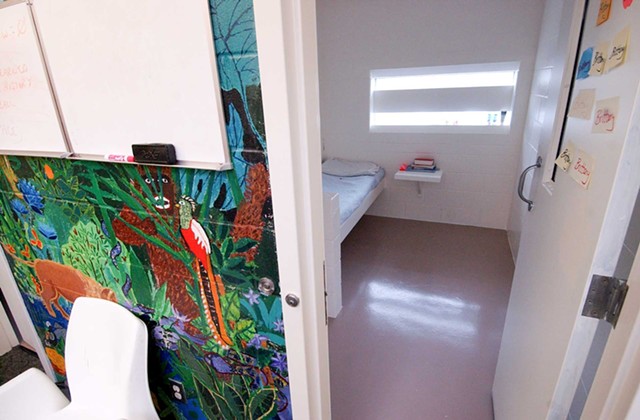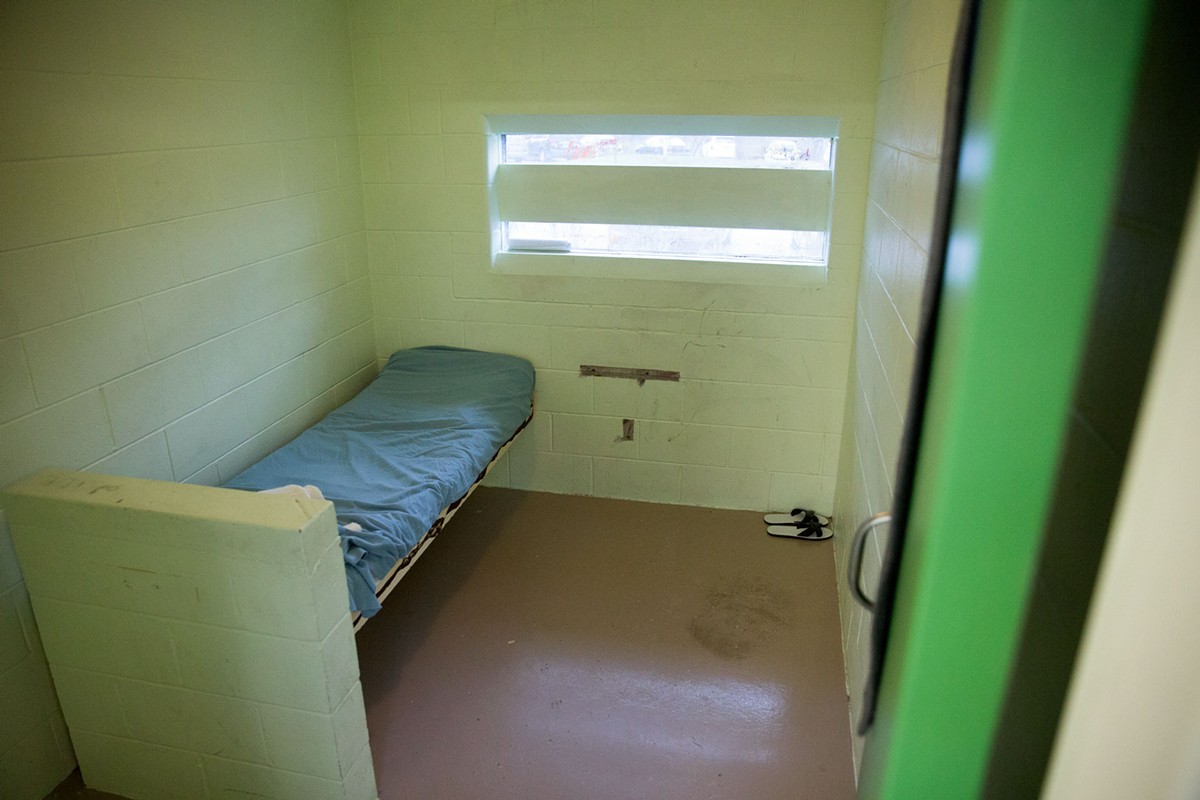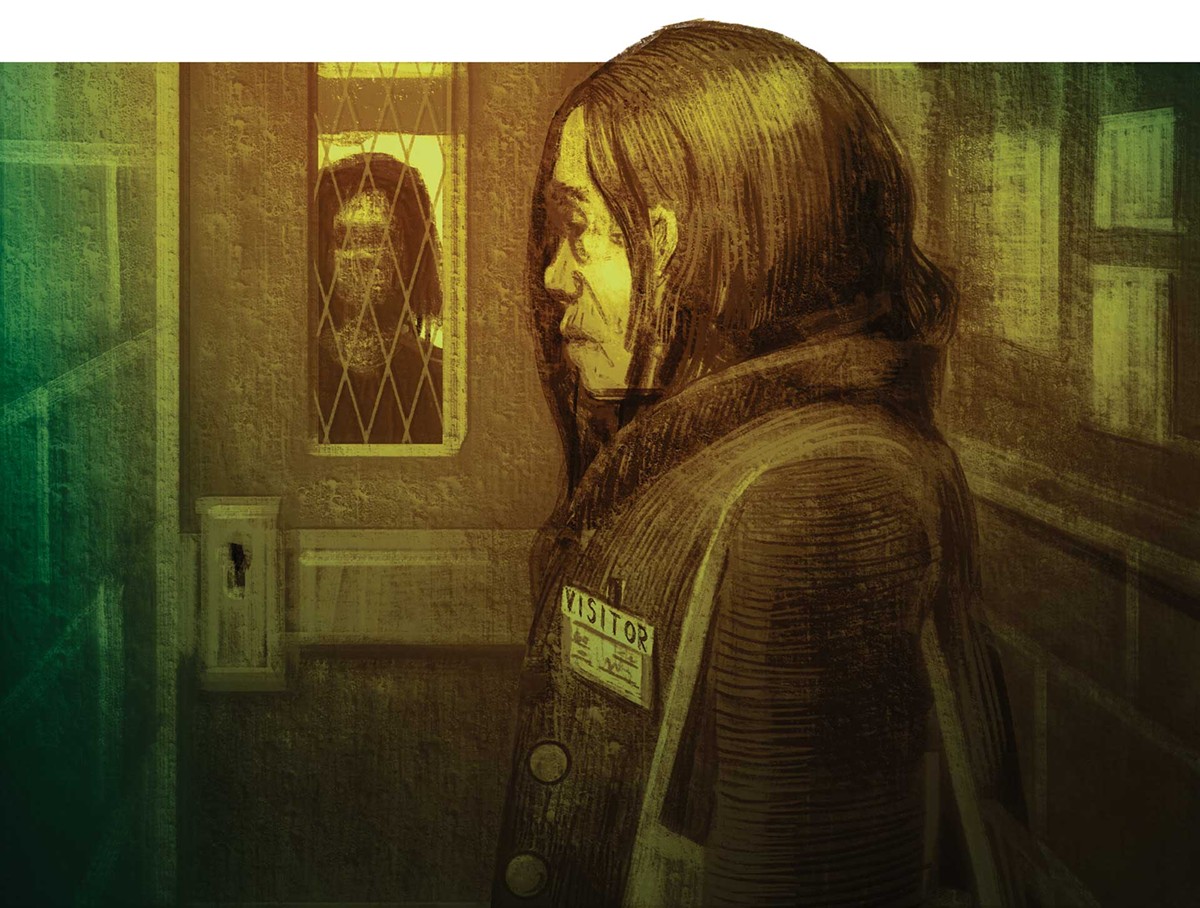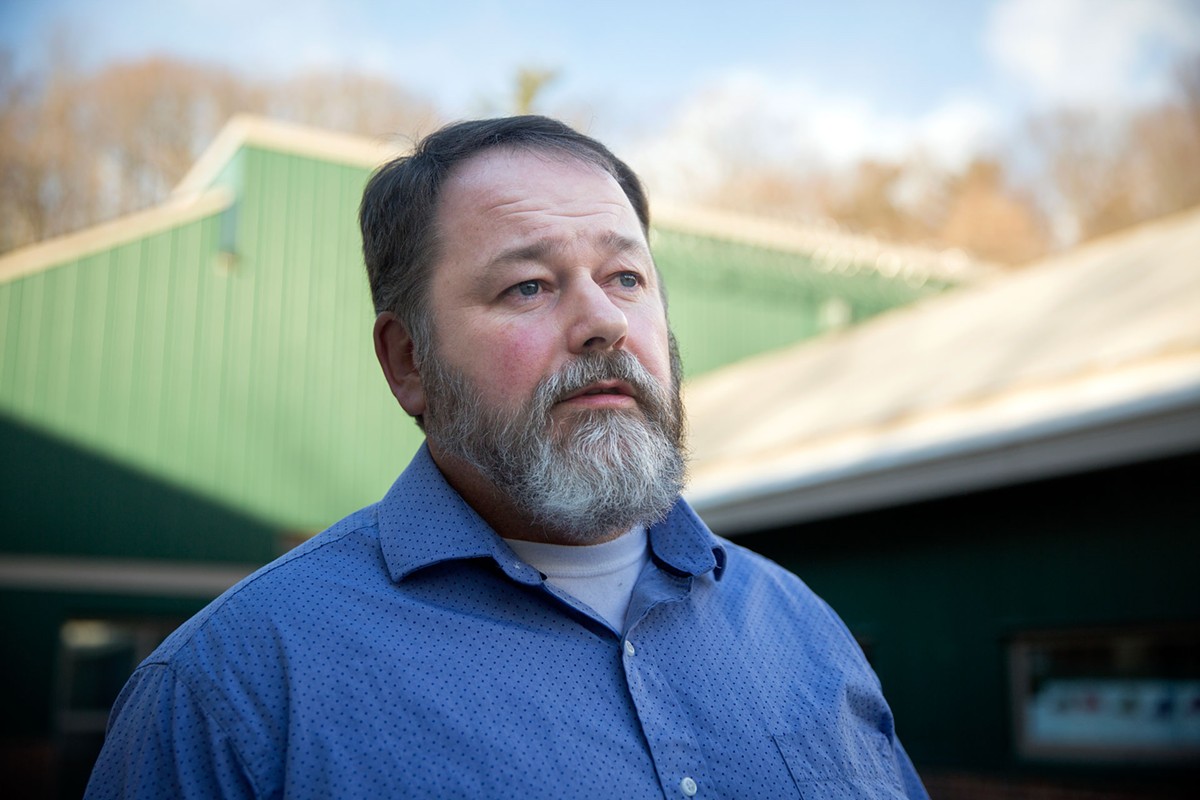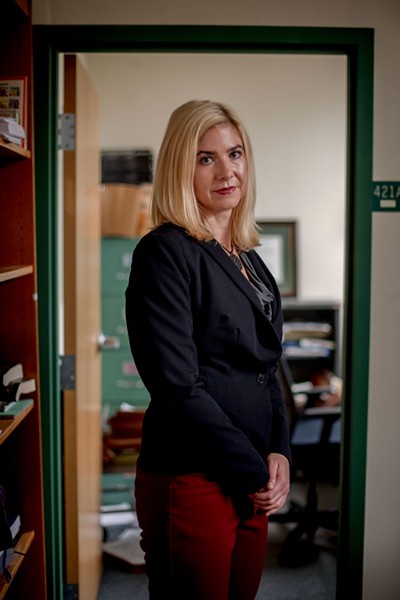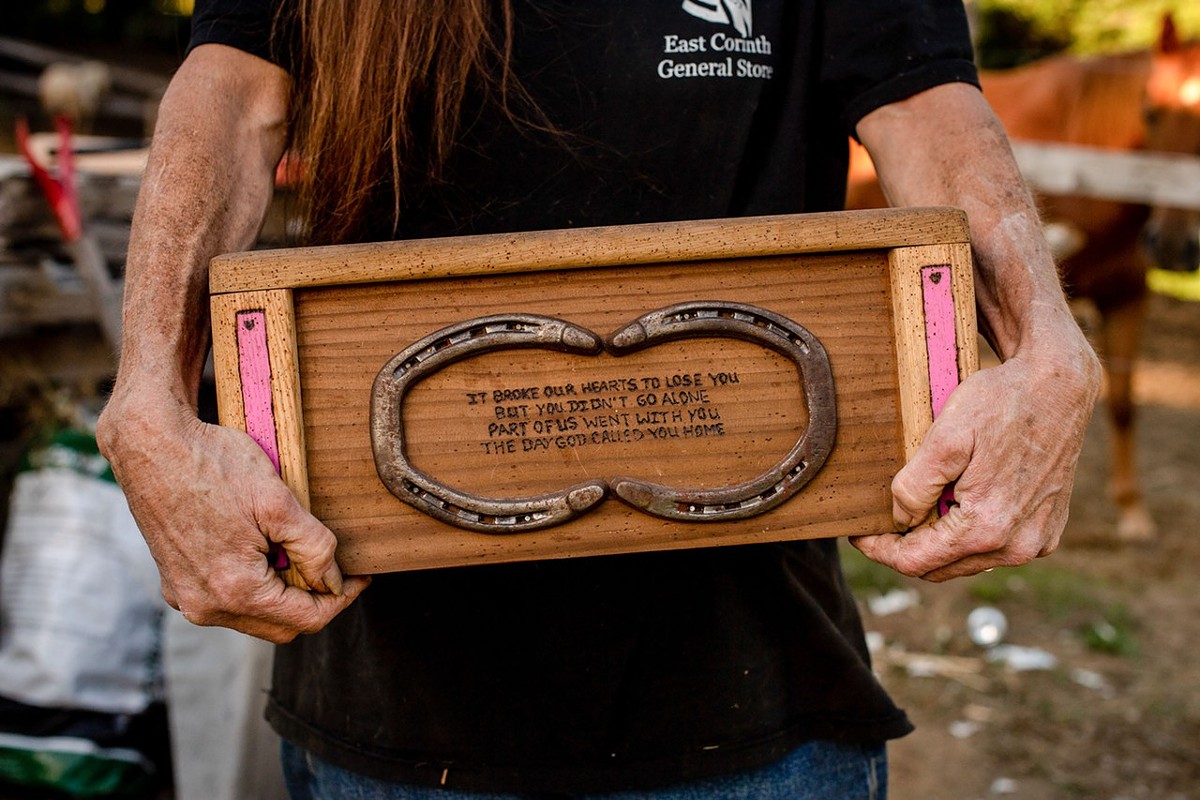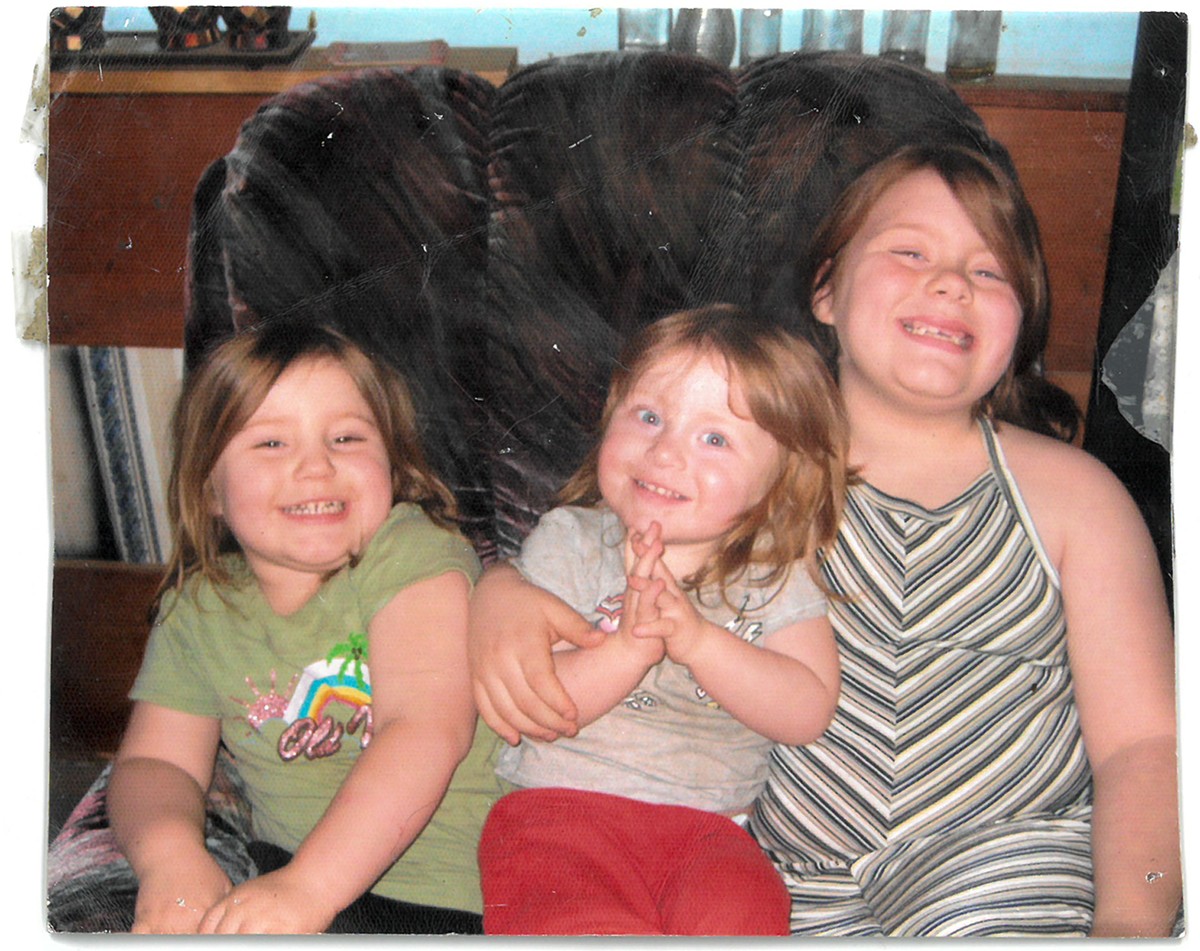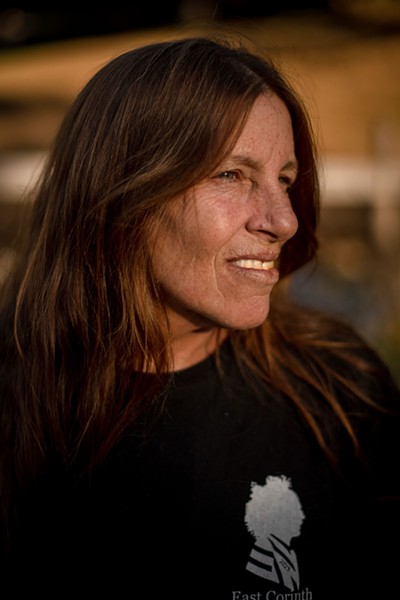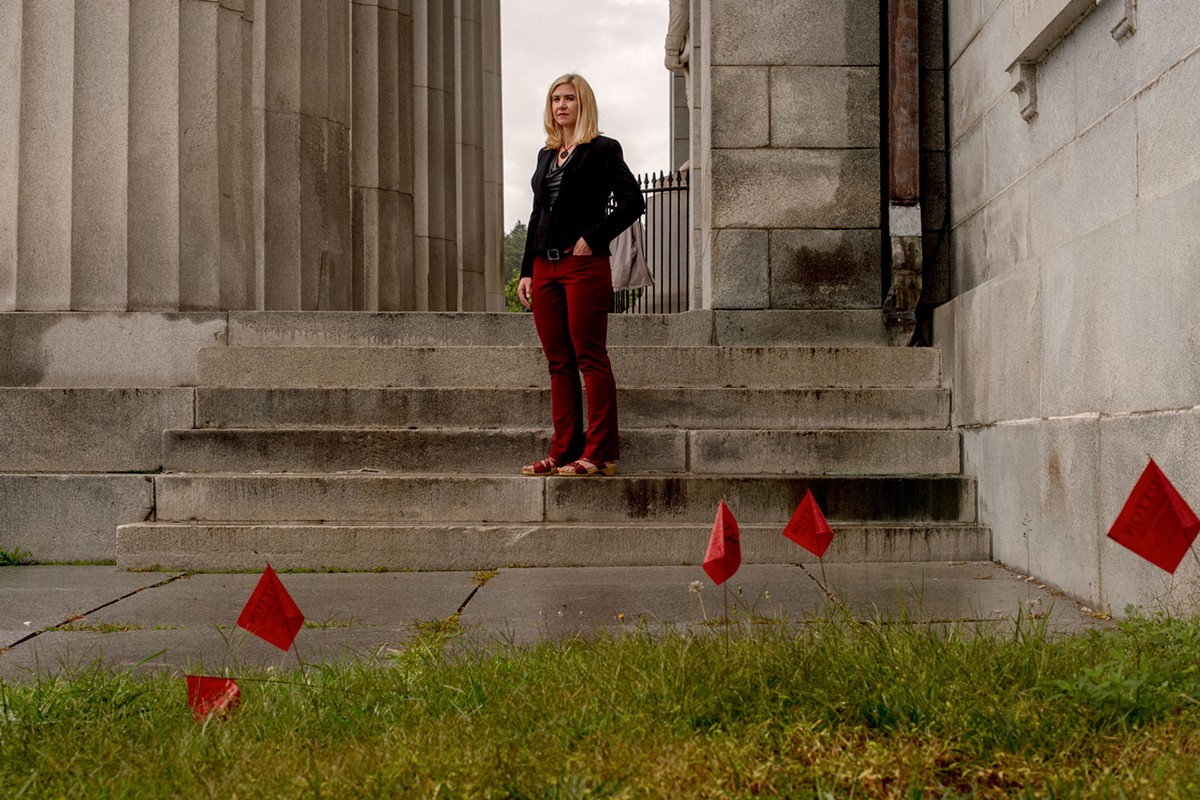The video is being shot by a female staffer at the Woodside Juvenile Rehabilitation Center in Essex. The camera looks through a window in the door of the room. The child comes to that window, and it is clear she is in emotional crisis. Yet her eyes possess a flash of warmth, and in that moment, it is not hard to imagine her early childhood of challenge and promise.
A girl raised in rural Vermont in a home without electricity, where buckets of water were used to flush the toilet and the family’s food was stored in a neighbor’s refrigerator. A girl who could ride a bike at age 3, who could switch-hit playing baseball at 5, who had a magical touch with animals and once walked into a circle of unruly Arabian horses, instantly befriending them. A girl who often went hungry but who made a point of bringing food to the homeless people begging outside her local supermarket.
At another moment, the girl in the video walks about the room laughing madly, her eyes swimming with hurt and fear. She sits on the floor and begins to harm herself — inserting lengths of wire into her right forearm. She does it carefully, calmly, without an expression of pain.
The woman working the camera does not open the door to intervene. She asks, “Why are you doing that?” and keeps the camera rolling.
Parts of the answer to the staffer’s question can be found in the girl’s thousands of pages of medical, police and child welfare records: She was taken from her family by the State of Vermont at age 11, given half a dozen shifting diagnoses of mental illness and prescribed nearly 20 different medications as she was shuffled from hospitals to specialized schools to placements out of state. At one, in Georgia, the staff sought to control her behavior using “chemical restraints,” heavy doses of powerful drugs meant to render her compliant. She’d lost cherished family members to cancer and car crashes. She’d been ostracized at school — called “the crazy one” and mocked for her lack of stylish clothing.
Reporting this story
The report is based on hundreds of pages of court, medical and police records; regulators’ findings; government correspondence; audiovisual materials; reports; and submissions to the Vermont legislature. It also draws from interviews with Grace Welch’s family and people who knew her; the family’s attorney; her court-appointed guardian; lawyers with Vermont’s Office of the Defender General; former Vermont attorney general T.J. Donovan; state legislators; the commissioner of the Department for Children and Families; former workers at Woodside Juvenile Rehabilitation Center; advocates for people with disabilities; an expert witness; Raven Hendrix, a former resident at Woodside; Eric S. Miller, general counsel for the University of Vermont Health Network; and email exchanges with former DCF commissioner Ken Schatz and his deputy, Karen Shea, former deputy attorney general Joshua Diamond and former DCF commissioner David Yacovone. Several sources are not named because they cited fear of retaliation.The girl had been at Woodside before, when she was 13. Then, she spent 11 days in a suicide smock, went without a shower for nine days, was kept naked and alone for days on end in the facility’s North Unit — four grim cells where children were sent to be isolated and where the staff often cut off water to the toilets and excrement piled up. She was restrained 31 times, her arms and legs bent and twisted by male staffers whose tactics were meant to get her to do what they wanted. She was denied the schooling at Woodside to which she was entitled by law, sent to court dirty and stinking as her family asked judges to please give her back to them.
Woodside, opened in 1986 and operated by the Vermont Department for Children and Families, could house 30 children from ages 10 to 17. The population was a mix of boys and girls with mental health issues, some of whom had run afoul of the law. They were supposed to be provided schooling, counseling and group activities. Later, after Woodside was rebranded as a rehabilitation facility, those kept there were to be provided therapy and treated for their mental health disorders.
The video, taken through the locked room’s window, captures the girl during her second stay at Woodside. For months before, she’d enjoyed some stability in her life at home with her family, the only place she’d ever wanted to be. Her attendance at school was nearly perfect. She was a valued volunteer at a nearby home for the elderly. But that peace was disrupted profoundly when she reported being raped by a local farm worker, with whom she’d gone out to pick pumpkins. “Look at the moon,” she said the man told her as he forced himself on her. She was sent to Woodside after she took a truck belonging to a friend of her father’s for a dangerous joyride.
In a life of myriad miseries, the girl resigned herself to more.
“Pain is good,” she said in an intake interview. “I deserve it to hurt.”
Much of the hurt administered at Woodside was filmed by the cameras that its director, Jay Simons, required staff use to record their interactions with the children. “No, no, no,” the girl screams during one violent encounter with male staffers as they cut her pants off. “I can’t breathe,” she sputters in another. “Let go. My back. I promise I’ll walk,” she pleads in yet another. Once, a paramedic answering a 911 call found the girl in her cell, naked in her own menstrual blood and urine, so cold that she was at risk of hypothermia.
The video of her naked and stained with excrement was shot days after that episode. The child — resentful, willful, creatively reckless — could act out, and this time she and other children had succeeded in causing a round of mayhem for the staff. In such instances, the workers who would restrain her could don biohazard suits and break out riot shields. They didn’t want the shit on them. They would drag her to her cell, dump her and dash backward out through the door.
The woman recording the scene inside the white room says she is not enjoying it.
“I don’t like to see you hurt yourself,” she says.
The woman speaks with another staffer, and it is clear that the two are weary of the treatment of the girl and the others kept in the North Unit. Those children, to be sure, could often be a threat to themselves or the staff and a problem for the workings inside Woodside — tying clothing or other material around their necks, damaging property inside the facility, disrupting life for the less troubled residents. Over decades, best practices have been developed for how to care for and protect children in such moments — ways to ease tension and upset, protocols for listening, offering respect, rewarding safe behavior. Making such moments about power and punishment almost always worsens things for traumatized children.
Under Simons, lawyers for the children would assert, power and punishment were the fundamental approaches to control in the North Unit at Woodside. The price the children paid was high.
Kerrie Johnson, a lawyer with the Vermont Office of the Defender General’s juvenile unit, said children kept in isolation for weeks or even months devolved into compulsive self-harm because of their loneliness, helplessness and boredom. They would strangle themselves with their clothing, then staff would forcibly strip them naked. Some tried to burn themselves, while others refused food and water. Children could become catatonic, seeming to lose touch with reality. Some would use their fingernails to carve words or shapes into the paint on their cell doors. One carved a set of animals and talked to them.
The woman filming the naked girl talks to her colleague about the toll it is taking on those who must enforce such policies. She confesses to her colleague that she does her best to keep it all inside. “If I showed emotion...” she says before failing to finish the thought. “I can’t,” she adds. She says she can’t even talk about what goes on at Woodside with her husband.
“I’m emotionally dead inside,” a male staffer responds.
The child continues to insert the bits of wire into her arm. She does it with the concentrated ease of someone knitting. She gets up and kicks her leg in a little dance. She then comes again to the window, holds her arm outstretched to show the camera. “I can’t feel my arm,” she says.
Simons was one of the men who put on a biohazard suit and then put his hands on the children. He participated in the frontline work of violently restraining them. Lawyers for the children alleged he had no problem with men restraining naked girls, some of whom were victims of sexual assault.
Now, he is at the window of the child’s room.
“Oh, look at that,” he says jokingly to the child with the wires in her arm. “You’ve got some piercings.” To a staffer, he adds, “Get a close-up with the camera.”
Simons was a former Vermont prison boss who had no formal background or specialized training in caring for children, much less traumatized adolescents with mental health and behavioral issues. His second in command, another former corrections employee, had a poster in his office off the front lobby. It was a chart of the human body labeling where maximum pain could be inflicted with the use of a baton.
“Not qualified to lead this facility,” Christopher Bellonci, an assistant professor of psychiatry at Harvard Medical School, said of Simons in a sworn affidavit.
“Traumatic, unnecessary and dehumanizing,” Paul Capcara, a nurse with a master’s degree in public health, said in a sworn statement about conditions at Woodside.
The Defender General’s office said Woodside’s clinical director, Aron Steward, condoned and helped oversee what was done to the children at Woodside — the violent restraints, and the extended isolation in the North Unit — despite ample research detailing the harm done to children kept in such conditions. In 2020, that office accused Steward of having repeatedly testified falsely under oath about her professional credentials, including during proceedings that involved the placement and detention of children at Woodside. In January 2023, the Vermont Office of Professional Regulation cited Steward’s alleged misrepresentations and charged her with “engaging in conduct of a character likely to deceive, defraud or harm the public.”
“Good at putting a stamp of legitimacy onto this otherwise completely barbaric practice,” Johnson, the lawyer with the Defender General’s Office, said of Steward’s role in the treatment of children at Woodside.
Vermont’s history of scandals involving children is long and ugly: the eugenics work done in the 1920s, including with families at the Weeks School in Vergennes, in pursuit of legalized sterilization; the abuse at St. Joseph’s Orphanage in Burlington; the children handcuffed to their beds in the juvenile unit of the Vermont State Hospital in Waterbury; the dozens of pedophile priests in the Burlington diocese who preyed on boys and girls; the mistreatment of students at Kurn Hattin Homes for Children.
And yet what happened in the North Unit at Woodside was allowed to go on for years — much of it known to the most senior officials at the Department for Children and Families, including then-commissioner Ken Schatz, and the office of then-attorney general T.J. Donovan. Claims of violence at the hands of staffers, stays in what amounted to solitary confinement, administrators and medical personnel coercing children into withdrawing their complaints of abuse were all laid out in court filings, memos and emails from the children’s lawyers and in the multiple and damning reports by DCF’s own internal investigators of inhumane conditions and negligent care. A paramedic who had rescued the bloody and freezing girl even wrote directly to DCF about what she had seen — not only a child at risk of death but a staff ignorant of her history and unconcerned that a girl naked but for a smock was being dealt with exclusively by men.
The circle of knowledge, however, went well beyond the state’s child welfare and top law enforcement offices. At least six different Vermont judges heard cases alleging damage was being done to children at Woodside, and none of them intervened to demand meaningful investigations or order an end to the mistreatment.
The state legislature also had plenty of reason to know of the problems at Woodside. Advocates testified before its committees and personally sought out individual legislators to encourage them to investigate. Formal proposals were submitted about how to reform the policies and conduct of the staff at the facility. None of it provoked decisive action or, in truth, all that much interest.
Johnson filed many of the cases seeking emergency relief for the children in the North Unit at Woodside. She testified about Woodside before the legislature. She wrote directly to Schatz, the DCF commissioner, beseeching him to act and offering her own plan for key reforms. Schatz and others at DCF sought to have Johnson professionally sanctioned for her fierce advocacy.
“There is a certain exceptionalism that is baked into the culture here in Vermont,” Johnson told Seven Days. “Out of that exceptionalism, it is almost axiomatic that while such things as what took place at Woodside may happen in other places, they cannot happen here. When I talk with people outside the state about Woodside, they always respond the same way: ‘Vermont? Really? That happened in Vermont? No way!’ How the rest of the country sees us is also how we see ourselves. Because we cannot believe that such things can happen here, they do. And often.”When I talk with people outside the state about Woodside, they always respond the same way: “Vermont? Really? That happened in Vermont? No way!”Kerrie Johnson
All along, officials at both DCF and the Attorney General’s Office sought to keep the videos taken of the children at Woodside from the public. Management at Woodside told staffers that the videos were meant to protect workers from claims of malpractice. The staff, for their part, suspected that they were a management tool to find fault with their work and weed them out in favor of more people with corrections backgrounds. But again and again, DCF and the Attorney General’s Office worked to keep them secret — demanding they be filed under seal in court cases and denying them to a lawyer for some of the damaged children and their outraged families.
Bellonci, the expert from Harvard, ultimately got to review the videos — a boy knocked flying through the air, another screaming that his arm was being broken — including 32 involving the naked girl alone in the white room. “Horrifying and deeply disturbing,” he wrote in an affidavit, saying the incidents amounted to child abuse that, in another setting, could be criminally prosecuted.
In June 2019, the advocacy organization Disability Rights Vermont filed a sweeping federal lawsuit seeking an emergency halt to what was taking place at Woodside, saying children were being irreparably harmed by the violent restraints and extended and humiliating stays in the North Unit. In response, Simons defended the restraints of the children as safe and maintained that children were only sent into seclusion for their own good.
Federal Judge Geoffrey W. Crawford got a chance to see some of the videos, and he quickly determined Woodside was “an institution in need of systemic change and reform.” He noted the violence of the restraints, the catalog of damning findings made by DCF’s own investigators and the abusive use of the North Unit’s seclusion cells. He ordered DCF to revamp its policies for restraining and isolating residents.
It would be the beginning of the end for Woodside.
Schatz, the former DCF commissioner, and his top deputy, Karen Shea, told Seven Days in separate statements that they had done their best to provide care to extremely troubled and vulnerable children and had been clear with the legislature and others about the limits of what they could do for those children — constraints owing to funding and the physical plant at Woodside. In sworn testimony, Simons was even blunter: Woodside had become a place of last resort not set up for or capable of successfully treating some of the most damaged children sent there.
The naked girl in the video, Simons later said in court, was one of those children. At the end of the video, the girl ultimately winds up collapsed in a corner of the featureless cell. She looks exhausted and defeated.
Her name was Grace Welch. In the video, she is 16.
Lawyers would win her release from Woodside, and she would rejoin her family and work hard to piece together a future. She discovered basketball, graduated high school, dreamed of adopting a puppy. Hungry for love of any kind, with anyone, she found her first boyfriend. He was years older than her, and Grace’s family said he introduced her to illicit drugs. She would not give him up.
Grace died of an overdose two months shy of her 19th birthday.
After Judge Crawford’s ruling, Grace and six other children held in the North Unit sued the state for their mistreatment at Woodside, but lawyers hired by then-attorney general Donovan argued that Grace’s claim of damages did not survive her death. Her family was owed nothing.
A modest celebration of her life was held at a ball field near her grandmother’s place in East Corinth. Grace, daughter of Josie and Gene; granddaughter of Cathy; sister to Faith, Hope and Little Gene. Today, a handmade box holding her ashes rests inside Cathy’s hillside trailer, the horses Grace loved out back. A tribute is etched into the borders of the box:
“She was the perfect example of grace because she was a butterfly with bullet holes in her wings that never regretted learning to fly.”
This is that child’s story.

‘A Horror’
Grace Welch was born on December 17, 2002, the first child of Josie Farnham and Gene Welch. Josie and Gene had known each other throughout their childhood, and their subsequent romance was a whirlwind.“He’s like, ‘You wanna go four-wheeling?’ And I’m like, ‘Sure.’ And he threw me over his shoulder and threw me in his truck and away we went,” Josie said of their courtship.
Josie, who was kicked out of her childhood home at 13 by her abusive, alcoholic mother, would drop out of high school when she became pregnant with Grace, and she and Gene would set up a spartan home on a piece of property in West Topsham. Gene was one of the “Welch boys,” hardworking, hard-drinking loggers and machine operators who were not easily bent to 21st-century norms.
“Short in stature, high energy, hard to teach,” George Denagy, a neighbor, said with an admiring chuckle. “Intractable pains in the rear.”
And deadly serious about certain core things, such as family and loyalty.
“Nobody messed with the Welch boys,” Josie said. “They’re very committed to each other.”
Grace’s records and interviews with those close to her offer glimpses into her early life, some of them consistent, others conflicting, none of them comprehensive. She was certainly a child of Vermont’s countryside, roaming the forests, driving ATVs, at ease with animals and wildlife and the grit of rural life. Energetic, happy-go-lucky, strong-willed like a Welch girl, she could be a handful, too. When Josie took her to kindergarten for the first time, she alerted the teachers that Grace might have some form of ADHD.
Grace’s files, though, include evidence of hardship and trouble, too. There’s a clinical note suggesting Josie struggled with alcohol as had her mother — showing up drunk at the bus stop to send Grace off to school, requiring hospitalization more than once. Another included a claim that Josie’s drinking could lead to fights with Grace. There are references not just to frugal circumstances but to impoverished ones. There was no running water, electricity or phone in the family home. Grace would be sent to her grandmother’s to bathe every other night. “Desperately poor,” one assessment states.
School did not go well, and one psychological report in Grace’s files includes a theory that might help explain why.
“Sometimes youth like Grace who grow up in rural environments and have limited experiences away from their family with other children and adults, once they enter public education, can present as overwhelmed, and with what some have termed ‘environmental autism,’” the report says.
According to Grace’s mother and paternal grandmother, the local elementary school in Orange made things worse. Grace was routinely sent for hours to the school’s empty and windowless “blue room” for misbehavior. Cathy Welch, Grace’s grandmother, said Grace never spoke of her treatment at school, and the family only learned about this after it had been going on for months. Over two years, Cathy said, Grace was forced to spend parts of 200 days in the room. School officials said by law they could not comment on Cathy’s claim.
There were attempts to treat Grace’s behavioral issues — one listing of them included impulsivity, aggression, running away — with a variety of medications and a stay in the hospital. Grace, at 86 pounds, was sent home from the hospital with a prescription to take the maximum adult dose of Seroquel, a powerful medication meant to treat serious mental illnesses such as schizophrenia, bipolar disorder and depression.
Grace’s family could not make sense of the diagnoses or medication regimens, other than to conclude that they did not help much. “I met with 14 professionals with a whole bunch of college degrees and none of them could tell me what was wrong with my daughter,” Gene, Grace’s father, told a psychologist evaluating his daughter at one frustrated moment.
Cathy Welch, her grandmother, came to believe that Grace suffered from some kind of multiple personality disorder — often a reaction to trauma meant to keep painful memories at bay. Cathy even named Grace’s second distinct personality “Gracezilla,” saying she surfaced when Grace felt cornered or endangered. Over the years, Cathy said, she begged the authorities to take her seriously, without success.
The state’s child welfare agency came for Grace when she was 11. The department’s case file is not public. But there are notes from her other records indicating that the state took her into its custody because of neglect. She was missing too much school; Josie couldn’t supervise her medications diligently. Cathy said it was nothing more than a confusion over Grace’s medication lapsing during a holiday.
Whatever the full truth, it was harrowing for the child and her family. The state police accompanied DCF workers to get Grace.
“They came at night, woke her up out of bed,” Cathy said.
At an early court proceeding, Grace said she wanted to be returned to her family.
“Grace looked at the judge and said, ‘I’m gonna make everybody’s lives a living hell until I go home,’” Josie recalled. “And from that day forward, she did just what she set out to do — made their lives miserable. Did it help her? No. But that girl is stubborn. Oh, my God. Stubborn.”Grace looked at the judge and said, “I’m gonna make everybody’s lives a living hell until I go home.” And from that day forward, she did just what she set out to do. Made their lives miserable. Did it help her? No. But that girl is stubborn. Oh, my God. Stubborn.Josie Welch
Grace’s records reflect that there was considerable confusion about her intellectual abilities. Some records say that at age 12, she couldn’t list the months of the year or spell the word “world.” Others showed that she tested at a superior level for verbal comprehension and perceptual reasoning. Her IQ scores varied. Her brain was scanned in the hunt for answers, and Grace herself later offered a child’s take on what had been found.
“My brain never stops,” she said.
There’s nothing in the record to suggest these efforts were anything but well intentioned. They are full of generous observations about Grace: her desire to make friends; her work ethic; her devotion to, and need for, her family. “Grace is creative and enjoys learning practical knowledge and applying that knowledge,” one history reads. “When she is in a good space, she is charismatic and has a good sense of humor. Grace is also very persistent and works hard to get what she wants.”
But it’s also hard to read the records and not see the work on Grace’s behalf as scattershot, almost improvised, inadequate — done by multiple people in multiple places unable to solve the puzzle of this child.
John Turner served for several years as a court-appointed guardian for Grace. He admired her family’s dedication to her. They attended every court hearing; they visited her wherever she was taken; they fought for her.
“I’ve worked with lots of kids who didn’t have half the commitment of their families that Grace had,” Turner said.
But in DCF, he said, that family was up against an agency that he said fancied itself “on the side of God” and that was populated by people from backgrounds far different and more privileged than Grace’s.
“These people are out of another century,” he said of the Welch family with a mix of respect and regret. “They had a hard time understanding why people were coming for Grace. Looking back, Grace didn’t have a shot.”
Josie, Grace’s mother, certainly felt overmatched.
“She needed DCF to get out of her life,” Josie said of Grace. “She needed DCF to give us a chance, to actually listen to us. All she needed was her family.”
The family sought her return in court, but the losses just stacked up.
“We’d go in; the lawyer would say their thing; DCF would say their thing,” Josie recalled. And the judge would say, ‘We agree with the state.’”
From ages 10 to 16, Grace would repeatedly be admitted to the Brattleboro Retreat, the only inpatient psychiatric hospital for children and adolescents in Vermont. Staff on the child unit during her earliest stays called in as many as 10 daily “Code Greens,” urgent requests for assistance from across the hospital in physically restraining her. One of those people often called in to help was Paul Capcara, then the clinical manager of the adult intensive unit.
“It could be all day long,” Capcara said. “She probably set the record for the most codes at the Retreat.”
Capcara, a registered nurse with a master’s degree, and others intimately familiar with the Retreat said its staff was too often overwhelmed, undertrained and ever changing. Records show that regulators found it out of compliance with standards for care. Budgets were strained. A child there died by suicide. Judith Christensen, a former senior official at Woodside, said children arrived there from the Retreat with “suitcases full of medications.” Advocates considered litigation to compel improvements but didn’t sue only because they struggled to find experts to testify.
Capcara never personally assessed Grace, but over the years, at Brattleboro and, later, during Grace’s trips to the emergency department at the Central Vermont Medical Center, he would come to know her well and eventually testify as an expert on the harm being done to her and others at Woodside. Capcara said he came to mistrust all the various diagnoses involving Grace. For him, she suffered from attachment disorder — a painful but common problem for children who have had inadequate or abusive caregiving at home or in residential facilities, and who might have suffered a series of traumatic losses.
“In order to keep themselves safe, these children act out,” Capcara said. “Because it gets you attention, and it gets you lots of people who hopefully will help keep you safe.”
He said Grace might have been something of an outlier in terms of the severity of her problems, but the issues were recognizable and conquerable.
“All she wanted was someone to engage with her, treat her with respect and listen to her and, you know, be with her,” he said. “And if you did that, she was charming. She was a lovely young girl. She was smart; she was capable. She actually had insight, which, you know, sometimes you don’t see in people that are in those settings.”
Woodside under Jay Simons, then, was about the worst place Grace could wind up. Yet that’s where she was sent in 2016 after she damaged property and struck a staffer at a therapeutic group home.
Then 13, she was nude during early testing upon her arrival; her clothes had been taken so she could not rip them and try to strangle herself. She’d eventually spend six weeks without access to clothing while being kept in the North Unit, given a safety blanket of material that could not be picked apart and that felt like a stiff piece of burlap, her lawyer said. She spent nine days straight in a locked room. She was not allowed to attend any educational sessions for months. She was not even allowed a book in her cell. She went days without bathing.
Locked up, with no physical activity and a steady diet of medications, she put on so much weight so quickly that stretch marks formed on her body. She raged and harmed herself, including stuffing plaster from the walls in her ears.
A psychiatric evaluation done around this time points to the problems that Grace experienced when she was placed in facilities.
“It is this examiner’s opinion that referring Grace to another secure program will not lead to any improved functioning,” it reads, “and likely only increase the distrust that Grace’s parents and Grace already have toward service providers.”
Kerrie Johnson, the lawyer with the Office of the Defender General, came to represent Grace. Johnson has a master’s degree in social work and had spent seven years in a variety of positions with DCF before going to Vermont Law School. She’d been trained in how to peacefully resolve volatile situations with children; she’d learned how to restrain them without injuring them; she’d managed a caseload of children and families at risk; she’d done investigations.
She’d never encountered anything like the North Unit at Woodside.
“I don’t think at the time our office had a ton of information about what was happening there, or how that was used, or when it was used, or why,” Johnson said of the North Unit.
She quickly figured out what was taking place there.
“A horror,” she said. “I would leave that place, and I would be like, This stuff is so awful you could get the United Nations to care about it.”
She said the leadership of DCF and the Attorney General’s Office would prove more challenging.
Johnson, in lodging a grievance on Grace’s behalf, met at Woodside with Simons and one of his bosses, DCF deputy commissioner Karen Shea. She knew Shea from their time together at DCF. Everyone agreed to having the meeting recorded, and Johnson laid out the mistreatment of Grace. She told them staff had to use VapoRub when they entered Grace’s room to ward off the stench of feces and urine. She noted that Grace, who couldn’t exercise, worried about her weight gain. She lamented her lack of schooling; Grace was denied access to books. She pointed out that Grace, then 13, was naked in front of male staff and had no mattress to sleep on. Grace had despaired that she’d never get out and had grown more and more withdrawn.
Listen to Johnson outline concerns to DCF:
"Little to do"
Likens treatment to "abuse"
Sanitary and water issues
Lack of privileges
She made the case for decency. It was an urgent one.
“Grace is young. She’s only 13 years old, but, emotionally, she’s even younger,” Johnson said to the DCF chiefs. “I can’t imagine how long the days must feel to her in here. Every day is just — is the same. It’s very repetitive, very monotonous, very low stimulation. And she’s a kid who is used to being active, living in the country, spending most of her time outside. It’s a huge change for the negative for her, and I think it’s really showing in her functioning. I think she doesn’t understand what, exactly, it is she needs to do.”
Shea said she would get back to Johnson — and rejected the grievance that same day.

‘It Was Crazy’
There is little dispute today that the creation of Woodside was a bad idea, born in a moment of hysteria about juvenile crime. In 1981, in an outrage still seared into Vermont’s collective memory, two 12-year-old girls were attacked in Essex Junction, stabbed and sexually assaulted, with one left dead. The culprits were two boys, 16 and 15.Vermont at the time did not have a secure facility for children accused of crimes. There were some group homes and foster families, but the unit for juvenile offenders at the state hospital had been closed down after its own scandal. In what felt like an instant, there were calls to build a locked facility bigger than had ever existed in the state.
Judith Christensen, now a senior lecturer in psychological science at UVM, was one of the people charged with bringing Woodside into existence. Some state legislators wanted a facility with 130 beds.
“Every kid on the corner needed to be put in an institution,” Christensen recalled of the prevailing sentiment. “Of course, it was crazy.”
Woodside opened in 1986 off Route 15 in Essex in an isolated stretch of forest along the Winooski River, its perimeter ringed by barbed wire. It wound up with 30 beds, more than were needed, but less crazy, Christensen said.
Crazy, less crazy — Vermont’s Defender General’s Office thought Woodside was illegal. Children were being sent there without the approval of a judge. The lawyer who helped lead the legal challenge to Woodside was Ken Schatz, the man who would later oversee and defend Woodside’s operations as commissioner of DCF.
Christensen became Woodside’s clinical director. Over more than a quarter century, she said, she hired staffers with degrees in social work or mental health counseling. She herself wore a suicide smock in solidarity with the children for whom that was a necessary safety precaution. The sleeveless, collarless garments are made of tough material that can’t easily be torn. She kept staff assigned to the same shifts to maintain consistency and familiarity with the young residents.
A nurse who worked for Christensen at Woodside described it as a place where pediatricians and psychiatrists visited regularly; therapy plans were discussed with families and included the input of the children being held there. Each resident was assigned a team that included a youth counselor, and there were periodic meetings with a child’s DCF caseworker and court-appointed guardian.
It wasn’t paradise, though. Christensen said Woodside had imperfections in its early years. Children who had committed truly violent crimes and been charged as adults were sent there because by law they could not be kept in adult prisons. Children stayed too long.
“We didn’t make it with all the kids, I’m not going to tell you that,” she said. “But we were pretty darn good at what we did.”
Christensen said she left Woodside not long after Simons, the former superintendent at the state prison in Newport, arrived in 2011. David Yacovone was the DCF commissioner at the time, and he selected Simons from what Christensen said was a pool of exactly two candidates. Simons had a military background and had worked at Ethan Allen Furniture before getting into corrections.
Once in command, Simons brought in people with similar corrections backgrounds. The North Unit, once a place children enjoyed going if only for the use of their own toilet, was turned into cells for seclusion.
“Staff became guards,” Christensen said.
Johnson said children on the North Unit could go unseen by doctors or psychologists. They were denied the right to choose the food they ate. They were forced awake and to bed earlier than the other children. Girls were denied tampons, not permitted to shave their legs and only given appealing toiletries as rewards. Victims of sexual violence were strip-searched upon entering Woodside, just as other new residents were.
Former members of Woodside’s staff spoke to Seven Days about Simons and his operation of Woodside, but none agreed to be named for fear their current or future work opportunities would be hurt.
“I don’t think there was a rhyme or reason to what happened,” one former youth counselor said. “It was just Jay’s way. His idea of safety.”
“It wasn’t long before we had to take mandatory classes on how to restrain a child and were taught to use codes over the walkie-talkies,” a nurse who worked there recalled. “Later, riot equipment was brought in: helmets, body gear and shields.”
“The people Jay hired were not there for the kids,” the nurse added. “They were there to get out of corrections while keeping their seniority with the state.”
One former supervisor said staff who had been there for years were never asked for their input, and this supervisor asserted that Simons and his methods must have had the blessing of people higher up in DCF. Indeed, Schatz’s deputy, Karen Shea, personally signed off more than once on the practice of children being held in the North Unit for longer than seven straight days, according to the Disability Rights lawsuit.
There was certainly no meaningful supervision from outsiders.
“Woodside policed itself,” the supervisor said.
“If you allowed them to be, the kids could be sponges for the positive things you were giving to them,” the former supervisor said. “In all my time there, I didn’t encounter one child who was beyond help.”
Yet those workers could do little to alter the prevailing atmosphere under Simons. They feared retaliation; they worried about their careers if they left the employ of the state.
“What was the alternative?” the former youth counselor asked.
Demoralized and marginalized, some staff members ultimately left; others soldiered on under a regime the former workers said was capable of harming children.
After all, lawyers for the children would argue, the system for restraining children under Simons featured the infliction of pain. One expert would later testify he’d never seen anything like it in a juvenile setting. Simons called the system “Dangerous Behavior Control Techniques.” He conducted multiday trainings on his technique, which involved holding children face down on the ground, their arms bent back behind and above them, legs bent at the knees, with feet set against their rear ends.
Simons admitted that restraints were painful, but he created a manual for his training and used his own son to show how it was done. He said in a sworn affidavit he was an expert in human anatomy and that his trained staff were too gifted to, say, cause the hyperextension of children’s joints. He would tell others that the children who complained they were being choked during restraints weren’t in danger; their ability to talk was evidence they could breathe — which is not true.
Christopher Bellonci, the Harvard psychiatrist, would give sworn affidavits and testimony about the treatment of children at Woodside.
“I am concerned that there is a high risk of a child being killed in the course of one of these restraints, particularly if the child is overweight or has asthma, as additional factors,” Bellonci testified before one of the judges who heard cases alleging abuse at Woodside. “I believe that it’s a high risk. It’s the No. 1 cause of death in restraints. And it’s the reason in most restraint modalities you are trained never to apply weight to the back.”
Children had the right to file grievances against staff members if denied necessities or subjected to physical harm. It was an empty exercise, according to the federal lawsuit, which cited numerous problems: Children were often denied the forms needed to file the complaints and warned that making the complaints would be deemed “negative behavior.” Children were retaliated against when they went ahead and filed the complaints anyway. Urgent calls for intervention could languish for months. One of the people who adjudicated the grievances was Simons himself.
Vermont, like almost every other state, has difficulty financing mental health care for its people, especially its children and adolescents. There are too few inpatient beds across the state; as a consequence, children wind up marooned in hospital emergency departments poorly equipped to care for them. The UVM Health Network, the state’s largest health care provider, has struggled to offer inpatient psychiatric care for children. The number of nonprofit organizations capable of delivering services to children in their homes and communities — organizations that are, in effect, the privatized agents of the state — is insufficient to meet the need.
“We’ve all been complicit,” said A.J. Ruben, a lawyer formerly with Disability Rights Vermont. “Not enough people, in communities and in government, care about these kids. We tell them and ourselves it’s their family’s fault. We do not fund remedies adequately. And the kids get chewed up as a result.”We’ve all been all complicit. Not enough people, in communities and in government, care about these kids. We tell them and ourselves it's their family's fault. We do not fund remedies adequately. And the kids get chewed up as a result. A.J. Ruben
At one point, DCF decided to apply for federal funding to bolster Woodside’s finances. It argued that Woodside could be a therapeutic facility where substantial treatment would take place.
“A scam,” said Vermont Rep. Anne Donahue (R-Northfield), who has worked on mental health care issues for years. She conceded that the state had put money toward improving the care inside Woodside. It was a scam nonetheless, she said.
“The driving force was to get Medicaid funds rather than the driving force being to improve quality of care,” she explained.
“I knew my path professionally, but personally it took me over ten years to work on my own experiences and recover enough to truly serve others,” she wrote in an online profile for a wellness consulting outfit with which she is associated. “To this day, I continue to strive towards my recovery ... Every day is a new day. Every person deserves as many chances and as much support as they need to build the life they want and deserve.”
However, Steward’s truthfulness about her professional credentials was the subject of an action brought by Vermont authorities. In January, an attorney with the Secretary of State’s Office of Professional Regulation issued a set of charges accusing Steward of having repeatedly misrepresented her training. While she has a doctorate in counseling/school psychology, she falsely claimed other degrees and certificates, including in art therapy and clinical psychology, the state alleged.
Those claims did not just appear on some résumé. Rather, the state alleged that Steward testified falsely about her training under oath in court cases determining the fates of children and their families, as well as in a criminal case.
Johnson said Steward sold DCF superiors and others on the idea that the North Unit at Woodside would offer children yoga sessions, as well as art and music therapy. Johnson said Steward called the North Unit a “low-stimulation environment,” what Johnson called “doublespeak” for solitary confinement.
Johnson said that in all her time in the North Unit, the only “yoga” she’d seen was “the brutal restraints” and the only music she heard was “staff playing a radio in the hallway for certain kids who demonstrated good behavior.”
“The closest thing to art therapy that happened back there were kids using their fingernails to chip away at the paint on the cinder block walls inside their cells,” she said. “Kids continued to be denied basic human rights like education, showers, sanitary living conditions, contact with peers, access to the outdoors, feminine hygiene products, basic freedom of movement.”
In sworn testimony, Steward defended Woodside as a professional operation. She said children were only secluded in the North Unit if they were a threat to themselves or others. Some, she said, chose to go to the North Unit to “self-isolate.” She said some of the staff that came from corrections were favorites of the children. She said she never personally took part in restraining children. The screams of the children being restrained at Woodside, she said, were not distinctive. People being restrained, she said, always screamed, whatever the setting — in adult prisons, in the street. She said some of the children at Woodside were simply beyond the place’s ability to aid. “There are some youth that have been failed by the system so significantly that we don’t have time to help them recover,” she said.
As for what Anne Donahue called the Medicaid funding “scam,” it worked for years before Medicaid officials called a halt to it in 2017. Their rationale was straightforward: The children at Woodside were not patients; the children were inmates.

‘It’s Like You Don’t Exist’
Getting in to see the child inmates was often difficult. Records show that lawyers on occasion were prevented from meeting with them; experts sent to evaluate the children, or merely contact them by phone, were denied access or had their meetings delayed. Grace’s family often was limited to looking at and talking to her through the locked door of her cell in the North Unit.“We’d have to stay on the outside of the door and stand there and take turns stepping in front of the little window,” Josie, Grace’s mom, said.
Lawyers for children at Woodside said the videos taken by Woodside’s own staff suggest why its leaders didn’t want parents or lawyers visiting: a boy who had been sexually victimized in an earlier placement by DCF held face down on his bunk with a riot shield as men cut off his clothing, leaving him alone and in his shorts for four days. A girl hurt by a worker who the girl said had punched her during a restraint. A girl who had been sexually molested by a relative having her pants cut off, exposing her genitalia for the men to see, and then left naked from the waist down for 48 hours. A boy complaining he could not breathe as a male worker drove his hand into his neck.
Those videos were obtained by DCF’s internal investigators, who in 2018 produced a withering list of ways staff had violated policies.
A sampling: After a child had lost consciousness during a suicide attempt, Steward, the clinical director, rejected the professional advice that the child be taken to the emergency room of the local hospital; the use of force was often unwarranted and the infliction of pain a violation of Vermont statutes; seclusion was used for punishment, and staff failed to adequately supervise the vulnerable children locked in their cells; residents’ rooms were often stripped of bedding and belongings; written goals set for the children in the North Unit were not specific to their individual cases but rather rote and generalized language; Simons on at least one occasion had misrepresented the facts in denying a boy’s grievance.
Critically, the investigators talked directly with the children. At least one did not hold back.
“What’s consent when you have five guys holding you down?” that boy said of how staff got them to do what they wanted.
Staff “pick at you until you blow” and “cover their bullshit,” he said. He added, “It’s like you don’t exist.”
The boy said Simons had told him that he would always back the staff “no matter what” in any dispute over the treatment of residents.
Presented with the findings of his own investigators, Schatz, the DCF commissioner, wrote a letter of response. He sought to place any troubles at Woodside in the larger context of Vermont’s inadequate resources for treating and protecting its children. The letter does not read as if it is addressing any kind of emergency.
Woodside faced unique challenges, Schatz wrote; it was the only facility in Vermont that had to accept any child sent to it, and so it was exempt from some of the rules that applied to other facilities. He worried about the hardships his staff faced. As for the children locked alone and without clothes or schooling in the North Unit, Schatz said there would be no “corrective action” until the state decided the long-term future of Woodside itself.
The lead investigator, Brenda Dawson, later testified that she’d never seen the work of her team disputed or disregarded so blatantly.
“Ken Schatz had a choice,” one former DCF manager said. “He could believe the state’s own regulators, or he could believe Jay Simons. He chose not to listen to his regulators.”
On October 31, 2018, Schatz met with those held in the North Unit to hear them out. They were as direct with him as they had been with the investigators: The North Unit was used for punishment, not treatment; the grievance process was a joke; the staff’s use of force was unnecessary. The North Unit should be shuttered, they told him.
It wasn’t.
Kerrie Johnson thought a personal appeal from her to Schatz might get results, so she wrote to him directly. He once led the office for which she now worked. He’d filed motions in court at the founding of Woodside, stating that the placement of some children there was unconstitutional. And Johnson had once worked for DCF during Schatz’s early years as commissioner.
Johnson wrote that she had been at Woodside once or twice a week for more than two years. She alleged, among other things, that she had seen how information and data about the workings of Woodside had been manipulated for outside observers, giving a false impression of Woodside’s performance.
“As a former DCF investigator, it takes a lot to shock and dismay me. I am shocked and dismayed at Woodside on a regular basis,” she wrote to Schatz. “Moreover, the lack of accountability for staff who hurt residents and perpetuate a culture of silence in the face of resident maltreatment is deeply troubling.”
Johnson said Schatz was not moved to act decisively.
As for Simons, Johnson said she had no better luck with him.
“He’s good at talking. He picks up on information quickly, and he figures out how to kind of integrate it into his repertoire for justifying stuff, making everything that he did sound normal and reasonable,” she said of Simons. “He testified in the legislature at times and would talk about the brain and the changes in the brains of kids who’ve been exposed to trauma. And so he could speak the language of being trauma-informed, but in my opinion there was absolutely nothing about anything that he did that was trauma-informed.”
Johnson did not shy from confronting Simons personally about the North Unit.
“I would be like, ‘Jay, you see what’s happening back there. That’s not OK,’” she recalled. “And then he would figure out a way to sort of make me feel like he was going to address some aspect of what I said.”
DCF in 2017 created a Woodside stakeholders group that included Shea and Simons, members of the Attorney General’s Office and Johnson herself. Johnson said it resulted in “paper” improvements. Simons agreed not to decide grievances that involved claims against him. Shea’s sign-off would become required for children staying more than seven days in the North Unit. But Johnson said the dangerous conditions at Woodside endured virtually unchanged.
Johnson did not let up. During 2018 and 2019, the Defender General’s Office filed court cases seeking immediate injunctions to stop the mistreatment of children at Woodside — in Rutland County, Orleans County, Washington County, Franklin County and Chittenden County. Schatz was named as a defendant; a copy of one formal complaint was hand-delivered to deputy attorney general Josh Diamond, a top lieutenant to T.J. Donovan. The judges who heard those cases included Mary Miles Teachout, Samuel Hoar, Helen Toor, Mary Morrissey and Thomas Devine.
Johnson typically brought the cases in Family Court, and the secret nature of the proceedings make it difficult to determine how the judges regarded her claims of abuse.
However, in one case brought in civil court, records show Judge Teachout had prepared an order demanding that Woodside end “the purposeful infliction of pain on children within its care.” The order went unsigned and unenforced when Woodside released the individual child on whose behalf Johnson had filed the complaint. The case was declared moot, and Johnson said Teachout rejected her appeal to go ahead and intervene nonetheless.
Johnson said she believes the judges gave a reflexive, undue deference to DCF, a department they might naturally have regarded as engaged in hard, virtuous work with vulnerable families. She said the children’s accounts — the very same kinds of accounts of mistreatment that DCF and judges tended to credit when, say, parents were being investigated for neglect or abuse — were not trusted. She said DCF and the Attorney General’s Office fought to prevent the judges from seeing the videos of the children’s mistreatment.
“We regularly litigated the admissibility of the videos, and that was hotly contested at every stage of the process,” said Marshall Pahl, Johnson’s boss at the Defender General’s Office.
Johnson said the case before Teachout was not isolated and that DCF ensured that none of the cases was decided on the merits by releasing children from Woodside before a case went to trial so that the actions brought by the Defender General’s Office would be declared moot and accountability would be avoided.
Johnson said she documented how Simons and Steward got children to withdraw their cases. In one instance, Johnson, on behalf of a damaged boy kept for months in the North Unit’s isolation cells, asked a judge to end the restraint policies that Simons had enforced. The boy later told his lawyers that Steward met with him at Woodside and told him that he had no chance at prevailing in court. He said she promised to give him more privileges if he told Johnson to dismiss his case. He said she also told him not to authorize his lawyer to gain access to his clinical notes at Woodside. Simons, the boy said, joined the pressure campaign, and the boy agreed to write a letter telling Johnson to withdraw her filing. The boy later refused to talk to investigators working on the complaint of another child. He said Steward applauded his “good choice.”
Of the judges, Johnson said: “I think it was just really hard for them to wrap their minds around that this could be real.”
The failure of anyone to act, Johnson said, left her questioning her own instincts.
“Is there something wrong with me? I’m seeing this as wrong and unjustified, and it’s actually justified,” she said she asked herself. “Am I the crazy one? Like, who do I call? Do I call 911? Do I call the FBI? Do I call the Department of Justice? Do I call fucking Ghostbusters?”Is there something wrong with me — I'm seeing this as wrong and unjustified and it's actually justified. Am I the crazy one? Like who do I call? Do I call 911? Do I call the FBI? Do I call the Department of Justice? Do I call fucking Ghostbusters?” Kerrie Johnson
In response to Johnson’s efforts, Schatz and his deputy, Karen Shea, sought to have Johnson investigated for possible ethical violations, writing a letter of complaint to the Vermont Professional Responsibility Board. Schatz and Shea claimed that Johnson had encouraged children at Woodside to decline treatment; that she had pressed on with court cases against the will of the children; that she’d inappropriately contacted DCF staff during litigation; that her visits with children at Woodside left the children agitated and potentially a threat to the staff; that she was rude and demanding and overly emotional, as evidenced by her once crying after watching one of the videos of a child’s mistreatment.
The complaint was dismissed, deemed unworthy of a formal investigation. Johnson is hard on herself all the same.
“There is a part of me that wants to personalize it and take responsibility for failing to advocate effectively,” she said. “I pissed people off, often without meaning to, and I don’t think that helped. I was a brand-new lawyer, and I didn’t know what I was doing when I started trying to address the issues at Woodside. Without any kind of road map for that type of litigation and advocacy, there was a lot of trial and error, and I made a lot of mistakes.”
Others think Johnson is a hero in a story with way too few of them.
“All of these other people are looking at what was happening at Woodside and talking about how they might, for instance, need more resources,” said Paul Capcara, who would testify in court as one of Johnson’s expert witnesses. “And she was like, ‘No, this is fucking fundamentally not OK.’ People were ignoring her, and she would not stop standing up and saying that. They told her she was being too emotional. They went after her job. They were making it clear: If you keep doing this, it’s going to cost you your career.”

‘A Huge Heart’
Late at night on May 17, 2019, Grace Welch, now 16, was brought by law enforcement officers to Woodside. She was in shackles after having stolen a truck belonging to a friend of her father’s and leading state troopers on a chase.“I act out,” Grace had said of herself years earlier. “I get the cops called.”
Now she had again. No one was injured in the episode. Taken into custody by the troopers, Grace talked of harming herself.
Outside Woodside, Grace refused to enter willingly. She once had declared that she’d rather go to jail than Woodside. She tore off a slice of her shirt and tied it around her neck. Yet upon her admission, Grace was not screened for risk, as was required. Woodside’s clinical director, Steward, had moved on, and the job had not been filled. Grace was put directly into a North Unit cell with nothing more than a blanket and a mattress.
Grace’s return to Woodside ended a roller-coaster year for her, one marked by personal growth, unfortunate repeats of damaging behavior and frightening stays in hospital emergency rooms.
Her records make for heartbreaking reading.
Grace had become a cherished volunteer at a rehabilitation facility for the elderly in Berlin. She read to one resident who long before had given up on books; another resident insisted that only Grace could help her with her makeup. Grace, whose weight gain had left her clinically obese, liked to exercise along with the residents. When there was a fire at the facility, Grace was credited with keeping the residents safe and calm.
“Grace is respectful, appropriate, shows kindness and empathy towards both staff and residents and both look forward to seeing her each day,” a supervisor wrote in a report.
The supervisor said Grace had a “huge heart” and had expressed interest in one day becoming a licensed nursing assistant. If she found a way to get the training, the supervisor said of Grace, “a job will be waiting for her.”
Grace, supported at home by both her parents and grandmother, had also been thriving in the one-on-one educational work she did every day with a teacher named Deb Hutchings. “Barn science” was one field of study, and she’d mastered practical things such as how to wrap a wounded horse’s leg and how to calculate the proper medication dosages based on a horse’s weight. She’d learned to ride and loved it. She was pursuing a certification so she could operate a tractor. She signed up for a forensic science class. Her attendance record was perfect.
To be sure, there was lots of work to be done.
“Grace can get into grumpy moods; I navigate these by setting clear limits,” Hutchings wrote in a summary of her engagement with Grace. “I’ve learned to speak ‘Grace.’ I redirect negative comments and do not engage in a power struggle.” Grace, among other things, was working on “how to be a better friend,” Hutchings noted.
“Her confidence in all areas is growing,” Hutchings said.
But for a child so used to hurt and setbacks, her blossoming came with worry. Grace worried; others worried for her.
“Success has scared her,” Hutchings wrote, “and a part of her doesn’t think she’s entitled to this kind of success and happiness. And she doesn’t have the tools to deal with it. Therefore she’s self-sabotaging herself.”
During 2018, Grace was taken by police to hospital emergency rooms half a dozen times. She’d never harmed anyone or committed significant crimes. Twice, she’d run off from school, once after a disagreement with the principal.
“She wasn’t Bonnie and Clyde or anything,” said Paul Capcara, the nurse who had become familiar with Grace at the Brattleboro Retreat. “She wasn’t capable of that kind of thoughtful bad acts.”
Another time, Grace had called 911 to say she was feeling suicidal. On one more occasion, state police brought her to the Central Vermont Medical Center after she’d tied a shoelace around her neck, her face turning blue. She reported that she’d been raped by a local farm-worker. Grace’s records do not make clear what, if anything, anyone did with the allegation and whether the state police investigated. The report, however, would become part of her formal record, and Woodside was aware of it when she arrived there in May 2019.
Because no psychiatric beds were available, the hospital stays in 2018 were hellish for everyone: Grace, her family and the medical personnel. Emergency rooms are not designed for lengthy psychiatric stays; at Central Vermont Medical Center, Grace spent as long as three weeks in a room without windows, losing track of whether it was day or night. And she could spin out of control, becoming violent with the staff, damaging property, harming herself in creative and gravely serious ways. She tried to swallow batteries and screws from a smoke alarm she took apart. She ran into walls. She punched a female nurse in the mouth.
Capcara was now the head of the inpatient psychiatric unit at CVMC. He said he’d spend 2018 struggling to get his staff to care for Grace in a way that would limit the drama and risk. The staff, he said, didn’t understand Grace or, perhaps not surprisingly, much like her. They were emergency workers, not psychiatrists.
Her stays became battles of will that left everyone frustrated and exhausted.
The episodes offered Capcara insights into Grace’s struggles in placements.
“So she was just a normal kid in the sense that she wanted people to care about her. She wanted to be engaged. She wanted to be listened to. She had a story to tell,” he said. “She definitely was able to get out of control in a spectacular way when things were not going the way she wanted them to go.”
“I spent the entire time trying to tell people to not put hands on her, to engage with her, talk with her, be present, be a human being, but don’t get engaged in this cycle of putting hands on her and restraining her and putting her in seclusion,” he said. “It’s a pathology. Please don’t treat her like you need to control her. She’s actually a fairly resourceful, capable, smart young woman. Engage her as a human being, and she will be fine. Treat her badly or try to manipulate her or control her, and it’s not going to be fine. I was like, ‘Trust me, she will prove to you that this will be more painful for you than it is going to be for her.’ And people just would not listen.”
Capcara, like other professionals, didn’t buy the idea that Grace suffered from multiple personality disorder. But he conceded there was something to Grace’s family’s insistence that she did.
“When you suffer trauma at a young age, there’s parts of you, literally parts of your personality, that get sort of formed and walled off,” he said. “I think Grace had a little-girl part of her that wanted to be loved and cared for. And then I think there was another sort of protector part of her that when she felt like she was getting abused or taken advantage of, that part would come out and be very aggressive.”
“But I don’t know what everybody was afraid of,” he went on. “She wasn’t going to murder anybody. She was killing herself. Be empathetic for that. It’s not a threat to you, and it’s not a threat to anybody else.”She wasn't going to murder anybody. She was killing herself. Be empathetic for that. It’s not a threat to you and it’s not a threat to anybody else. Paul Capcara
For Grace, then, Woodside was, according to Capcara, “the perfect storm,” a place “that basically uses coercion to get people to do what you want them to do.” It was a 24-7 trigger for Grace’s most willfully defiant behavior.
When Capcara saw the videos of Grace during her 2019 stay at Woodside, he wept. And raged at the explanation by Jay Simons and his staff that it was all normal.
“To have Jay stand there and say, ‘We treat these kids really well. I have proof on video,’” Capcara said, “and then you look at the video and you’re like, ‘Are you insane?’”
After Grace entered the North Unit on May 17, 2019, sustained turmoil followed.
On May 18, Grace packed plaster in her ears.
On June 4, Grace damaged a fire exit sign and tried to grab a staffer’s keys.
On June 9, Grace, furious that she was denied the use of tampons for safety reasons, tried to swallow the menstrual cup she was given as an alternative. Staff dislodged the cup but left Grace naked and alone in her cell. A 911 call was made when she started banging her head against a wall. The paramedic who arrived found Grace naked and dangerously cold, shivering uncontrollably, blood and urine on the floor.
The paramedic, Ashley Williams, said staff on hand did not appear to know Grace’s history and told her Grace’s only diagnosis was PTSD. They told her Grace had chosen to be naked. They said she was manipulative. The emergency responder was shocked that Grace was being overseen only by male staffers when female workers were available.The paramedic who arrived found Grace naked and dangerously cold, shivering uncontrollably, blood and urine on the floor.
Williams was so alarmed that she wrote directly to Simons. He wrote back saying he had forwarded her concerns to internal investigators and inexplicably invited her to apply for work at Woodside. Staff reports about the incident applauded their “quick response” and “knowing how to utilize their skills” for keeping Grace safe.
Woodside’s internal reports on the staff’s interactions with Grace called her homicidal and noted that she had assaulted workers. She flooded her cell in the North Unit and defecated on the floor. The reports listed Grace’s repeated attempts to strangle herself and threats to swallow a screw. The reports were self-congratulatory, describing how staff “carefully” rolled Grace over during restraints and applied “only the force necessarily needed” in order “to save her.”
For her part, Grace alleged that male staffers made sexual remarks to her and that staffers provoked her so they could be justified in physically restraining her and sending her to isolation.
Much of it was captured on videos taken by staff. Christopher Bellonci, the expert from Harvard who reviewed the videos involving Grace, said in a sworn affidavit that he knew of “no treatment facility that would forcibly remove a resident’s clothing while having male staff take videos of the juvenile.” What he saw was “antithetical to trauma-informed care” and in fact constituted “child abuse by the very agency responsible for ensuring youth are protected from such traumatic practices.”
Bellonci personally met with Grace to talk about her miserable standoff with staff.
“G.W. has expressed she doesn’t feel safe at Woodside, that she is not receiving any therapy and that keeping her in a locked setting is the very trigger for her current behavioral presentation,” he wrote. “She has proven incredibly resourceful in finding ways to self-injure all while under the supervision of Woodside staff who appear unable to break this cycle of suicidal behavior. I have no confidence that Woodside can prevent G.W.’s psychiatric decline and frankly am fearful that if something is not done soon to rectify the situation G.W is at risk of killing herself.”
Once more, the continued tumult at Woodside was known to DCF commissioner Schatz. He was aware that in December 2018, the advocacy group Disability Rights Vermont had begun to prepare a potential lawsuit against Woodside. The organization shared a draft with Schatz to see if he would act and make the lawsuit unnecessary.
Schatz told lawyers for Disability Rights that children who were suicidal would no longer be held at Woodside, though he would later reverse himself. He promised things would improve at Woodside, but the lawyers said they didn’t.
Schatz delivered an almost upbeat report to the state legislature in April 2019. He noted that 71 children had spent time at Woodside in 2018 and said it had cost some $6.2 million to care for them. The report cited encouraging numbers about lengths of stays at Woodside and reductions in how many children were being kept there. He did concede that the place amounted to a “jail-like facility” and that some children could spend years there.
Schatz disclosed nothing about the repeated court filings seeking an end to the mistreatment of children there. He did not mention a possible lawsuit against him and his department. He stayed silent about the videos his lawyers and those with attorney general T.J. Donovan’s office had fought so hard to keep from the public.
Schatz’s proposal for the future care of the children being sent to Woodside was maintaining, as he put it, “the status quo.”
On June 20, Kerrie Johnson filed a 16-page complaint in Chittenden Superior Court asking that a protective order be issued for Grace and that she be returned from Woodside to the custody of her grandmother. Johnson detailed the history of Grace’s most recent stay at Woodside.
“There are clear violations of Grace’s right to dignity, privacy and humane conditions, and it is difficult to conceive of meaningful treatment when she has been treated this way by the people charged with caring for her,” Johnson wrote. “Given Grace’s responses to institutional settings, treatment to address her mental health needs will not be successful unless it occurs in the community.”
Grace was left at Woodside.
Videos captured what happened next — three more violent episodes involving Grace naked and manhandled by men in biohazard suits utilizing a riot shield. Those videos would include the one of Grace, streaked with her own waste, inserting wires into her arm as the camera rolled. Late in that video, pain registers.
“Ow, motherfucker,” she says. “Ow. Ow. Ow.”
She is alone, her eyes alternately possessed of warmth and wide with terror. No one is coming to help. She is the child called “the crazy one” by classmates; the child with many diagnoses and medications; the child harmed by others and by herself; the child taken at age 11 by the State of Vermont for her own safety; a child, at that very moment, with just two years left to live.
On July 9, Johnson appeared at a hearing before Superior Court judge Thomas Devine. She said she had reams of documentary evidence of what had happened to Grace at Woodside. She had subpoenaed the paramedic who rescued a naked and freezing Grace. She had testimonials from people who had been part of Grace’s success at home over the previous year. And she had the videos that she was prepared to show Devine.
She’d never get the chance. Lawyers for the state suddenly decided they had no objection to Grace being released to her family, Johnson said. Grace could go home that day, they said. There was no need for the hearing.
The videos would stay secret. Woodside would stay open.

‘A Laugh in the Face’
In June 2019, Disability Rights Vermont filed a suit against Ken Schatz and his department. The lawsuit drew on the work done by Kerrie Johnson and others at the Defender General’s Office, as well as the reports done by DCF’s investigators. The complaint ran to 42 pages and asked a judge to grant a temporary injunction to end what it said was the suffering of children at Woodside.In response, lawyers with attorney general T.J. Donovan’s office said the case involved “past, isolated and alleged experiences of eight juveniles.” And establishing the “mere possibility of irreparable harm” was not enough to warrant the judge’s intervention, the lawyers wrote.
Karen Shea, who was now a former deputy commissioner of DCF, said in a sworn affidavit that efforts were already under way to improve things. DCF had hired an independent consultant to assess Woodside’s use of force techniques. It had reformed the process by which children could lodge complaints and be heard. It was working with local hospitals to improve access to higher levels of care. Simons in his own affidavit argued Woodside had to accept children sent there, no matter their needs.
“Woodside receives individuals that no other facility wants to treat,” he said. “In this context, it is difficult to understand what [the] plaintiff expects from Woodside.”
“I think many injuries can’t be seen,” Bellonci, the expert who had met with Grace, testified of the videos he reviewed. “Psychological injuries and trauma is not something that is always going to be imminently apparent. It’s hard for me to imagine how what I was seeing, and the trauma that I felt just watching this experience, would not cause irreparable psychological harm.”
In court, David McLean, a lawyer with the Attorney General’s Office, suggested that the videos could not be trusted; they might have been edited, he told the judge. That same lawyer, in defending the violent restraints of children, likened them to challenging yoga positions.
Simons himself testified. He defended his use of force at the facility as safe and effective, and he said his staff had never had to take a child at Woodside for outside medical care as a result of an injury inflicted by him or his workers.
He said the psychiatrists employed by Woodside to evaluate the children played a role in treatment decisions and had never raised concerns about the North Unit. The DCF investigators who had found his staff violating the children’s constitutional right to humane treatment had applied the wrong standard, he argued. The videos, he testified, were far from the full picture of life and care inside Woodside.
“Looking at an institution through a few videos is like looking at a scene in a play through a keyhole,” Simons told the court.
Yet under questioning, Simons acknowledged that Woodside was not a good place for treating the kinds of children who wound up there — and hadn’t been for his entire tenure.
“So you’ve been at Woodside now for 11 years?” A.J. Ruben, then a lawyer for Disability Rights, asked Simons.
“Eight years,” Simons responded.
“Would you agree with me that at least for the last 18 months or so you have been aware that Woodside, the actual physical plant of Woodside, is unacceptable and inappropriate for the mental health treatment that kids receive there?”
“I have been aware of that for eight years,” Simons said.
“So for eight years you’ve been the director of the facility and the whole time you’ve known the facility is inappropriate for the treatment that’s being provided there for kids?” Ruben asked.
“Yes,” Simons testified.
Asked about Grace, Simons described her as a serious threat to herself and others and admitted that she had been held in the North Unit for 10 straight days in her latest stay. He indicated that keeping her alive was no small accomplishment. But there were costs.
“I think any time we can’t treat their problems that that’s exacerbating their condition,” he said.
Just 18 days later, Crawford, having watched the videos, granted a preliminary injunction that required Woodside to immediately remedy its policies for restraining and isolating children. The record makes clear that he was appalled by the videos, especially the one of Grace naked and harming herself. “Horrific,” he called it.
“The treatment of this girl is entirely inappropriate,” Crawford ruled, “and demonstrates in the space of a few minutes Woodside’s limited ability to care for a child who is experiencing symptoms of serious mental illness.”The treatment of this girl is entirely inappropriate and demonstrates in the space of a few minutes Woodside’s limited ability to care for a child who is experiencing symptoms of serious mental illness. Judge Geoffrey W. Crawford
Soon enough, more than 30 years after Woodside opened and three years after Grace was first jailed there, the last child held in Woodside was relocated. In November 2020, it closed for good.
No far-reaching inquiry into what went wrong at Woodside was ever ordered or done — not by Gov. Phil Scott, not by DCF or the Agency of Human Services, not by police or prosecutors.
In a statement, Scott’s office said:
“The Governor and administration fully understand that individual, tragic incidents took place at Woodside, and adequate, clear and direct communication up the chain of command was an issue which complicated our overall detection of, and response to, those incidents. The Governor does not believe that is an acceptable outcome and it remains something we are committed to addressing so it does not happen again.”
Yet no one paid with their job. Schatz retired. Simons was awarded a new job within DCF, running the department’s office in Newport. He oversaw an office charged with assisting and protecting some of Vermont’s most vulnerable and at-risk children. Simons retired from work with the State of Vermont in August.
Asked directly and repeatedly when Scott had first learned of the harm being done at Woodside, and why no one had been disciplined, demoted or fired, Scott’s office did not respond.
Rep. Alice Emmons (D-Springfield), the longtime chair of the House Committee on Corrections and Institutions, heard testimony about the alarming conditions for children at Woodside. In an interview, she said she lacked direct oversight jurisdiction but had raised the concerns with colleagues on the Human Services Committee.
“Everyone was aware; everyone understood the gravity of it,” she said.
Sen. Dick Sears (D-Bennington) has long chaired the Senate Judiciary Committee, and care for the state’s troubled youngsters has been a lifelong concern for him. In an interview, he acknowledged that he and others could and should have done more to dig into what was taking place at Woodside.
Of the warnings, he said, “I don’t know if we recognized them or ignored them.”
Aron Steward, the former clinical director under Simons, found a job with the UVM Health Network. Her online profile said she “specializes in reduction of aggression and violence, limiting maladaptive behaviors in patients and trauma prevention and intervention.”
In an interview, Eric Miller, general counsel for UVM Health Network, would not say what, if any, kind of review had been done of Steward’s work at Woodside before she was hired. He said she had provided “excellent care” at the hospital in Plattsburgh and that UVM was “really happy with her.” Asked about the accusations that were pending before the licensing board that Steward had misrepresented her credentials under oath, he said it wasn’t appropriate to comment.
During an October 13 hearing, Steward formally admitted to repeatedly testifying untruthfully about her credentials in cases involving the treatment and detention of children at Woodside as part of an agreement with state regulators. Under the deal, approved by Vermont’s Board of Psychological Examiners, Steward will pay $1,500, have a reprimand permanently attached to her license and must complete coursework in ethical practices for psychologists.
Kerrie Johnson and another lawyer from the Defender General’s Office, Kelly Green, appeared at the hearing and criticized both the outcome and the process that produced it. It took three years, they noted, for the Office of Professional Regulation to file charges against Steward. The board, they argued during the hearing’s public comment stage, had been denied vital material about the nature and extent of Steward’s false testimony and her role in the mistreatment of children at Woodside. Johnson said she’d never once been interviewed during the investigation.
“The process seemed like it was really aimed at keeping information from the board,” Johnson said at the hearing. “And that makes me question what the point of the process is.”
Neither Steward nor Simons would agree to be interviewed by Seven Days.
Schatz declined to be interviewed and did not respond to a detailed set of questions. Late last month, he sent a statement saying he had unsuccessfully sought funding to make it possible for Woodside to provide adequate mental health care. He said staff were committed to doing what they could to care for the children but that “some of the practices at Woodside needed to be updated.” He claimed that the number of children sent to Woodside had declined during his tenure in charge of DCF.
Asked if he felt badly for the children harmed at Woodside or regret that they had been failed, Schatz said, “All youth who were sent to Woodside had significant challenges. I wish the best for each and every one of those youth.”
In a statement, Shea, his former deputy, said any “suggestion that I was aware of ‘harm’ being done to children is a gross mischaracterization.”
“My goal was always to keep youth placed at Woodside safe from harm — many times from themselves — and that was a goal I took very seriously,” she wrote. “As someone who lost my only sibling to death by suicide, I understand the devastation experienced by those left behind and worked with others to keep youth served by Woodside moving toward addressing the issues that brought them to us as well as the threat they posed to harm themselves and others. My work was always focused on helping them make it to another day so that they could grow and mature and, hopefully, find health, stability, love, and happiness.”
David Yacovone, who as DCF commissioner appointed Simons, said he could not remember having done so or why he had chosen Simons. He would not say what, if anything, he had learned of the methods employed by Simons, if he’d heard complaints about them or what he had done in response. Told that it seemed improbable he could not remember whom he appointed to one of DCF’s most sensitive positions in caring for children, Yacovone stood by his claim.
“You can bait the hook as you please,” he said, “but I will not bite.”
Former attorney general T.J. Donovan, whose office had defended Woodside and the people in charge of it, said he was obligated to represent state employees. He said he did not know the specifics of many of the allegations of wrongdoing and would not say what legal advice he’d contributed to defending DCF. Asked if he believed his obligation to defend state workers included those engaged in the mistreatment of children, he would not answer. Vermont’s current attorney general, Charity Clarke, who had served as chief of staff to Donovan, said through a spokesperson that she played no role in the defense of DCF.
In December 2021, David J. Williams, a civil rights lawyer, filed suit in federal court on behalf of seven former residents of Woodside, including Grace. The named defendants included Schatz, his deputy Shea, Simons, Steward and 18 other employees at Woodside. Williams had gained access to the videos of Grace, her full medical and legal history, Woodside’s records, and internal communications among DCF officials.
Outside counsel hired by Donovan’s office filed various motions to dismiss all or some aspects of the lawsuit. Senior management at DCF were immune from any claims of damages brought by the children who had spent time there, they argued. Senior officials had no duty to intervene to stop what was going on. Supervisors could not be held liable for the actions of subordinates. The U.S. Constitution’s Eighth Amendment protections against cruel and unusual punishment did not apply to children.
Williams said he had approached the Attorney General’s Office before filing suit in an effort to settle the matter out of court. He said that on the eve of mediation, the Attorney General’s Office pulled out of the commitment. Williams said he believed the state’s strategy of delay was based on the possibility the plaintiffs would be dead or in jail soon enough.
“We suspected, frankly, that it was going to be this game of attrition, that they could outlast our clients,” Williams said. “And in fact, that’s what happened with Grace.”
Williams placed responsibility for the state’s legal strategy with Donovan and his deputy, Josh Diamond, whom Williams described as the lead attorney dealing with the failed effort to settle the lawsuit.
“The state had two choices,” Williams argued. “They could accept responsibility and negotiate some kind of resolution that would provide our clients with financial compensation and maybe even an apology. They chose full, scorched-earth litigation. T.J. Donovan and Josh Diamond ran that litigation strategy.”
Diamond, like Donovan, maintained that the office was required to defend state employees, and he rejected Williams’ allegations as “beyond the pale.” He otherwise declined to answer questions about his role in defending Woodside.
Of all the others who had reason to know what was going on at Woodside — the workers there, the judges — Williams said: “Any of them at any time could have simply called the cops. Children were being abused.”
Donovan left office in June 2022. Gov. Scott installed one of his most trusted aides, Susanne Young, to serve as an interim attorney general. Within weeks, Young restarted mediation discussions, and in February the State of Vermont, conceding no wrongdoing, agreed to pay the child victims of Woodside $4.5 million. Each plaintiff got around $420,000. The state, in the end, included Grace’s estate in the settlement.
The money has provided little peace or sense of justice for the Welch family.
Grace, freshly traumatized, had emerged from her 2019 stay at Woodside and once more tried to navigate a way forward. She took up basketball and graduated from high school. But the pandemic derailed much of her constructive engagement with the world, including her work at the eldercare facility in Berlin. And her first romantic relationship with a man several years older than her sealed her fate.
Grace had begged her grandmother to let the man stay with Grace in the basement of her home, her family said. Cathy was suspicious of the man but could not risk Grace taking off. Not long after, Grace was found dead of an overdose in that basement.
Grace’s death shattered the tight-knit Welch clan. Josie and Gene lost their firstborn. Grace’s three siblings — Faith, Hope and Little Gene — lost their complicated, loyal older sister. Cathy lost the granddaughter she’d helped raise as if she were her own child. Vermont lost a candidate for a career in nursing.
Today, Cathy is incensed at what happened to Grace and regrets her decision to allow the young man into her house.
“Nobody could have walked away from that,” she said of Grace’s stints in the care of the State of Vermont. “Not what she had been through. And I think that God said, ‘You, girl, have suffered enough from mankind. It’s time to come home.’”
As for DCF, Cathy is close to speechless with fury. The payoff was no comfort but rather a fresh blow.
“Four hundred thousand dollars is a laugh in the face,” she said. “Oh, here’s your money back for us destroying your kid.“
Cathy said everyone who played a role in Grace’s saga seems to have a nice new job or comfortable retirement. She said the money the family got doesn’t include a price paid with real consequences.
“Grace withstood more than any kid should ever have to have withstood,” Cathy said. “They need to all be held accountable for it. All of them. Because right now, they all walked away scot-free.”
Kerrie Johnson, like Cathy, feels there has been little consequential reckoning with what was done to the children of Woodside.
“People haven’t been held accountable. Four and a half million dollars paid out by the state’s taxpayers and insurance carriers isn’t enough,” she said. “Top leaders losing their jobs, explicitly because of what happened at Woodside and other places like it, gets people’s attention. People losing their property to pay a judgment gets attention. Criminal prosecution gets attention. The reputational damage that comes from being named publicly as presiding over or defending Woodside gets attention. Also, getting the people who are in positions of power to publicly promise that what happened at Woodside cannot be repeated can create an ongoing level of accountability.”
Johnson said Grace deserved “to be remembered for who she was, not what was done to her.” A girl who liked to look good, who liked cute clothes. A girl who loved the outdoors and who had a gift for working with the elderly.
“The most important thing is that Grace loved her family,” Johnson said. “She would light up when she saw them. Anyone who saw them together could feel how much they cared for one another. Watching Grace skip across the street with her parents during an early December snowstorm after her release from Woodside in 2016 will remain one of the highlights of my career. Words cannot express how tragic it is that she did not have more time with those who loved her best.”
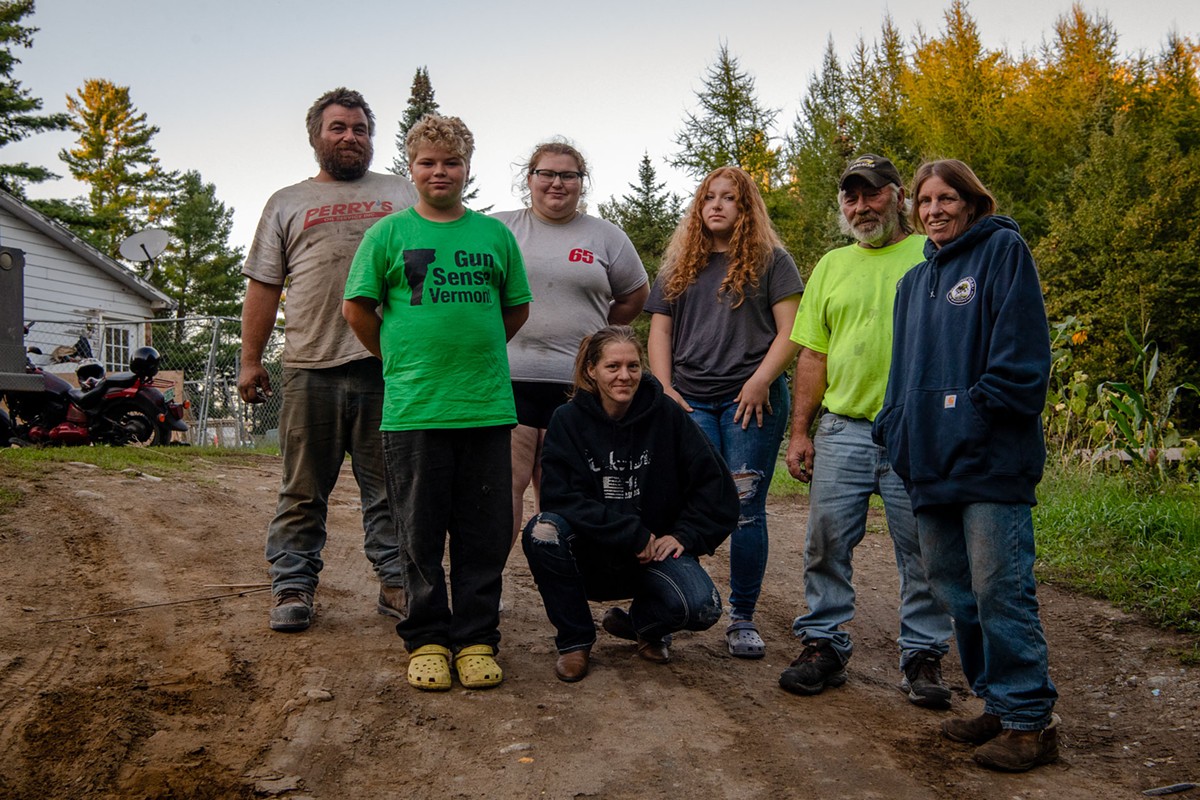

Epilogue
Chris Winters, the recently appointed commissioner of the Department for Children and Families, said the “ghosts of Woodside” haunt the agency. Anger, regret, worry — all of it, Winters made clear in an interview, had shaped a commitment not to repeat the tragedy.As a result, in the years since Woodside was closed, the state has developed a plan to do better. The plan involves opening four treatment centers — two secure structures to provide stabilization and care for troubled children caught up in the criminal justice system; a less restrictive place for any child in crisis; and a residential psychiatric facility meant to serve children with acute mental health or developmental issues.
Gov. Scott, in a statement, described his administration’s aims as “a comprehensive system of care which offers services at multiple levels, and which will rely on contracting with experts to develop and staff programs to best serve the complex needs of Vermont’s youth.”
But much of the plan remains just that — a plan. For instance, the effort to open a secure treatment facility in Newbury, one that would be operated by a private organization, has run into opposition from the community and the state workers union, and its fate is tied up in litigation.
Wherever the secure treatment center is ultimately located, Winters said, it won’t look or operate like Woodside.
“We don’t want it to be punitive,” Winters said. “We don’t want it to be corrections.”
Sears, the chair of the Senate Judiciary Committee, said he was deeply frustrated by the slow pace of progress. Children in need of care are stuck in jail or emergency room beds. Social workers and others out in the field, he said, are having to improvise inadequate solutions. He said he intended to hold hearings in November to take stock.
“Government is known for moving slow,” he said, “but not this slow.”
Sears, though, said he was certain there would someday be a secure facility for the most challenging children. He sees no other choice.
Kerrie Johnson, whose long fight helped lead to the closing of Woodside, is troubled by that conclusion. She has a raft of issues with the state’s plan. She thinks any kind of locked facility for children creates an environment where abuse can occur. The plan, too, contemplates mixing children as young as 10 with those as old as 22, another bad idea. Johnson did agree with the plan’s aim to have any such secure facility be run by an outside group. DCF’s dual role staffing and ostensibly policing Woodside had been at the heart of the tragedy, she said.
“We also need to look at who these kids are. How many of them first entered the system because DCF intervened in their birth family, necessarily or unnecessarily? I think many of the children of the North Unit would say they would have been better off if DCF had left them at home, because whatever they were facing there had nothing on what they ultimately came to experience at Woodside.”
Successful models have demonstrated that community-based therapies for youths who commit crimes can work, she noted. “Personally, that is where I think the state should focus its resources,” she added. “Kids don’t need coercion and control, and the vast majority do not require treatment in a locked environment. They need at least one adult who gives a shit and is willing to go to the mat for them. I think most of us know this to be true on some level.”
Since Woodside closed, DCF has sent some of the children who would have wound up there to facilities out of state. Those programs have their own troubled track records, including a facility in New Hampshire, the Sununu Youth Services Center, made notorious by widespread allegations it inflicted physical, sexual and psychological harm on children.
“The second chapter is as shameful as the first chapter, in my mind,” Rep. Barbara Rachelson (D-Burlington), a state legislator, said of the recent out-of-state placements.
The book on Woodside, of course, is not closed. In April, Brooke Cole, 21, another plaintiff in the lawsuit against Woodside, died of an overdose. Like Grace Welch, she had been held in the North Unit, subjected to isolation, forced nudity and violent restraints. She survived Woodside, though, and gave birth to two boys in the years after her release. However, DCF took the boys from her after an earlier overdose. Brooke died two months after her children’s removal.
“They took her kids away, and that’s the only thing she loved,” said Midge Gallagher, who had served as a court-appointed guardian for Brooke. “What did [she] have to live for?”

Today, Raven lives with his girlfriend and 3-year-old daughter in a trailer in the hills outside Richford. He has, at age 22, no high school degree and no job. It is unclear how much of the financial settlement he got from the state is left. He declined any professional assistance in managing what for him was a fortune.
On a visit in late summer, electricity to the trailer had been cut off for lack of payment. Raven, who spent weeks in isolation in the North Unit, suffers from profound PTSD. He can be short-tempered and suspicious. Inside his darkened trailer, he wore a hat that said “Fuck ‘Em” pulled over his face, his eyes hidden by hair.
Of the day he turned 18, and thereby aged out of Woodside, Raven said it was the “happiest day of my life.”
But his life after has become its own uncertain jumble. His girlfriend was targeted by men with guns seeking some of the money he’d got in the lawsuit. He hates Richford, a town with pockets of drug dealing and crime. He feels judged by people who know of his brutal upbringing. He has little clue about what will become of him. And he beats himself up for what he thinks is his own role in his circumstances.
“I was a bad kid,” he insists. “I wasn’t all there. But I tried.”
Johnson represented Raven, as well, and she both fears for him and mourns what he and the other children of Woodside endured.
“The seven Woodside plaintiffs deserved better. The hundreds of other kids who suffered in the same way as the plaintiffs, but weren’t included in the lawsuit, deserved better,” Johnson said. “Every kid who could have or might still wind up in a place like that deserves better. I hope we have learned our lesson, at least for now.”


Journalist Joe Sexton has previously reported and edited for the New York Times and was a senior editor with Pro Publica. He lives in Vermont with his family.
To learn more about Sexton and why Seven Days published this story, read this week’s “From the Publisher” column from Paula Routly.
- To join the major donors who support Seven Days' work through JFP, email publisher Paula Routly at [email protected].
- Or help us pay for in-depth stories like this one by donating monthly as a Seven Days Super Reader.
If you have feedback about this article, please write a letter to the editor or reach out to our team at [email protected].
•
